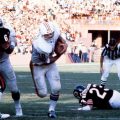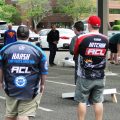Blog

The Miami Dolphins Perfect Season: Undefeated For 50 Years
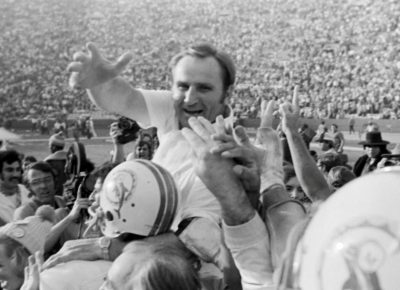
Half a century since the Perfect Season of 1972, no team has put all of the pieces together to match the feat. MiamiMan caught up with Larry Csonka and Manny Fernandez from that destined team, along with coach Don Shula’s son David, to celebrate the 50th anniversary of the achievement. (Here is the article as it appeared in the magazine.)
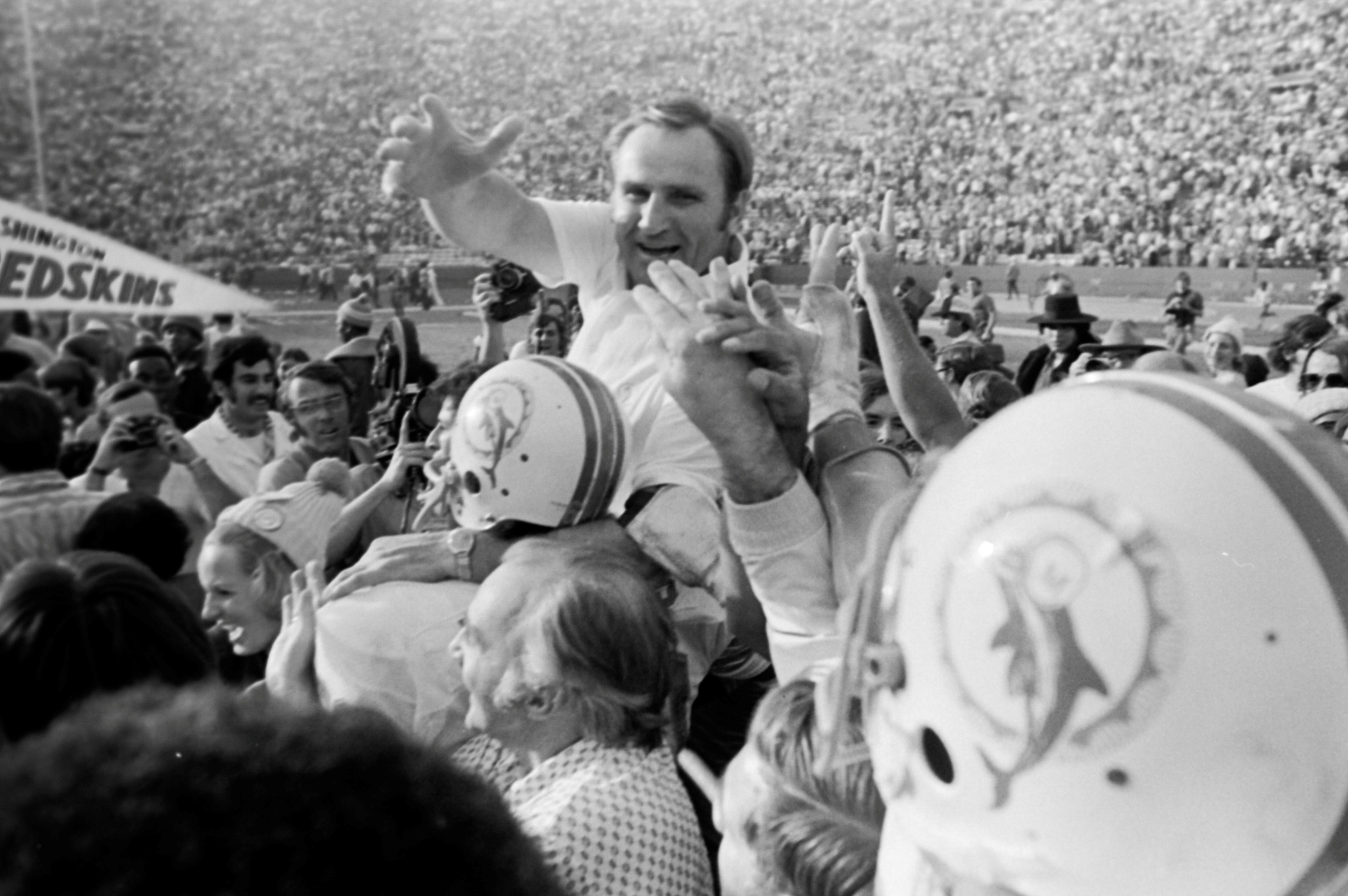
Everyone knew who the best coach was.
(Photo courtesy of the Miami Dolphins)
With the AFC Championship on the line, Larry Seiple defied the winningest coach in NFL history.
The punter for the 1972 Dolphins didn’t receive the signal to run a fake from his coach. He simply saw the hole the Pittsburgh Steelers left open…a hole his grandmother could have run through, he told reporters. Reacting in the moment, Seiple held the ball and ran 37 yards.
Seconds later, a touchdown pass from Earl Morrall to Larry Csonka tied the game. That touchdown turned out to be the difference. The Dolphins won by four points.
There might have been a very good reason Seiple’s coach didn’t signal for a fake. Seiple might not have seen a charging defender. He might have tripped on the play. A Steelers defender might have stripped the ball.
Had it not worked, Seiple is fond of saying, he probably would have walked home from Pittsburgh…because Don Shula wouldn’t have let him on the plane.
But because it worked, because Seiple followed his instinct, the Dolphins became AFC Champions. Because a special teams player thought independently in the heat of the moment, the Dolphins went to the Super Bowl to complete an undefeated season.
Because Larry Seiple stepped up in a clutch moment, the Miami Dolphins of 1972-73 have stood alone to this day as the only team in NFL history to have won every single game of a season.
One clutch play.
As Csonka says, that’s how finite it gets.
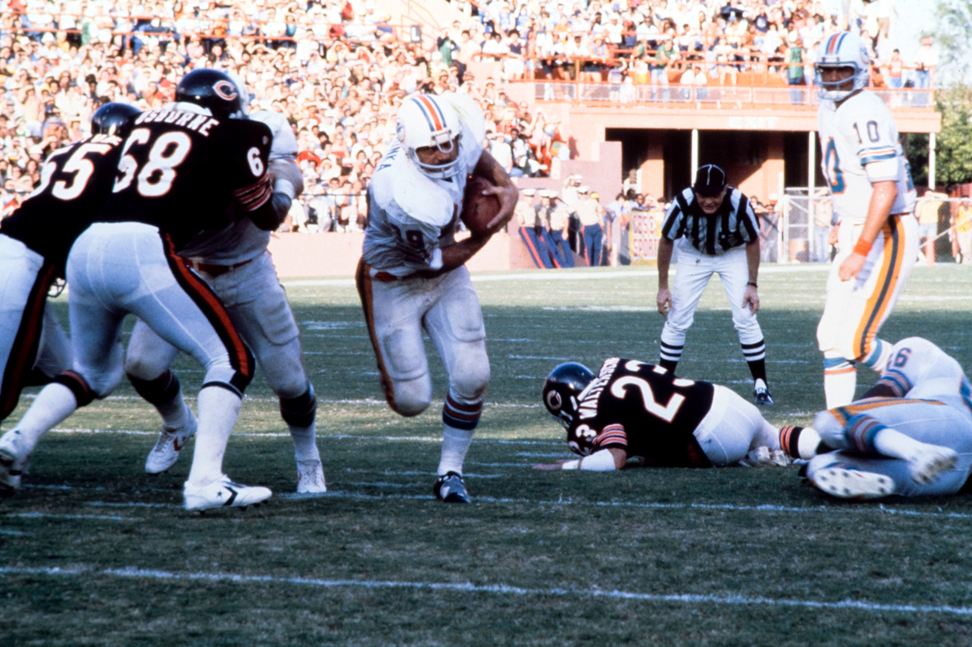
The Dolphins were always happy to give Zonk the ball.
(photo courtesy of the Miami Dolphins)
The point of highlighting Seiple’s moment of defiant intuition isn’t to suggest that a Perfect Season is a result of luck or even Divine Intervention…although a case could be made for a benevolent God smiling on a devout coach who attended Mass on a daily basis.
The point is to underscore the reality that to go an entire season undefeated, a team needs contributions from everyone, and a coach that relentlessly drills the importance of commitment and unity into them.
The 1972 Miami Dolphins weren’t lucky. They were a very, very good team…as any member of the team will be happy to tell you.
“Some people made a small contribution because he only got on the field at a certain time on one play,” Csonka remembers, “and other people made a larger contribution, but the fact of the matter is without all the contributions, you don’t have the Perfect Season.”
David Shula, son of the legendary coach, spent a great deal of time working in the team’s summer training camps as a young lad. He remembers what made their bond special.
“So many great people, not just great football players. You talk about guys like Bob Griese, and Nick Buoniconti, Larry Little, Larry Csonka, you know, Paul Warfield, Howard Twilley, Jake Scott, just tremendous human beings and great members of the community.
“They truly enjoyed being around each other,” he continues. “They wanted to win for each other more than they wanted to win for themselves, and really cared about each other and played for each other as a result.”
Manny Fernandez, one of the many stars of the absurdly nicknamed “No Name Defense”, also doesn’t see the Perfect Season as being luck or destiny.
“It was more everybody, every play, trying to do what they could. Those big plays that turned close games into victories, it was a different player every week coming through, whether it was a Dick Anderson interception or a Charlie Babb blocked punt or me stealing a handoff.
“And then, of course, we did have those games where we just beat them handily.”
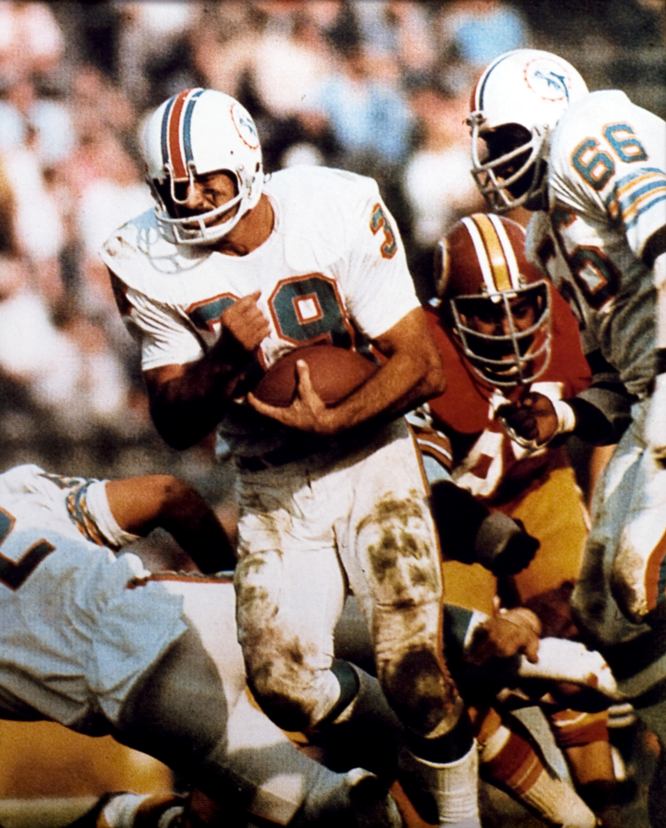
Running with one purpose…revenge.
(photo courtesy of the Miami Dolphins)
There was one key motivation that every Dolphin shared going into the 1972 season…a humiliating 24-3 loss to the Cowboys in the Super Bowl the year before.
Fernandez remembers it all too well.
“Losing the Super Bowl,” he still reflects with a sigh, “is the worst feeling in the world. You work so hard to get there. It’s hard to explain the disappointment.
“I bought 100 tickets for that game for family and friends. A lot of them were at the hotel we were staying at, waiting for us to come back. I had to take a break in the parking lot, just literally sat on the bumper of a car and let the emotions run. I was in tears, I had to compose myself before I could go in and face everybody. I just felt like I’d let my whole family and all my friends down, not to mention the fans in Miami.
“I think to a man we vowed, we weren’t gonna feel that way again next year. No matter how hard Shula pushed us or how hard he worked us, we knew why, we knew where we needed to be, and what we needed to do to get back and redeem ourselves.
“That whole season was redemption.”
Csonka remembers that Coach Shula was emphatic that every game in 1972 was going to be treated like the Super Bowl.
“Had he anticipated that we were going undefeated? No, I don’t think he had any design on that. Just how serious we were going to approach every game, so that by the time we got to the Super Bowl, if in fact we did, we would be ready and know how to prepare. And that part was a prediction and that part did come true.”
The coach, Zonk and Manny both remember, used every edge on the field…including Miami weather.
“He decided that we would practice twice to sometimes four times a day in 90 degree heat,” Csonka recalls, “and we would become camel-like so that we were acclimated to that tropical situation. Any kind of little idiosyncrasies like that, he used those as added gunfire in the battle.”
Fernandez wasn’t always a fan of playing in the intense Miami heat, though.
“You get on that poly turf, and the temperature of the surface would be 120 degrees, and the air you’re breathing is 110. There’s no doubt it gave us an edge, but it also cut into us a little bit as well. There were more times than one I was getting intravenous fluids at halftime to keep from collapsing. It wasn’t always fun with that hot weather.”
Coach Shula demanded a lot, Fernandez says, but “the guys on the team, we respected him and what he was doing, and what it was doing for us.”
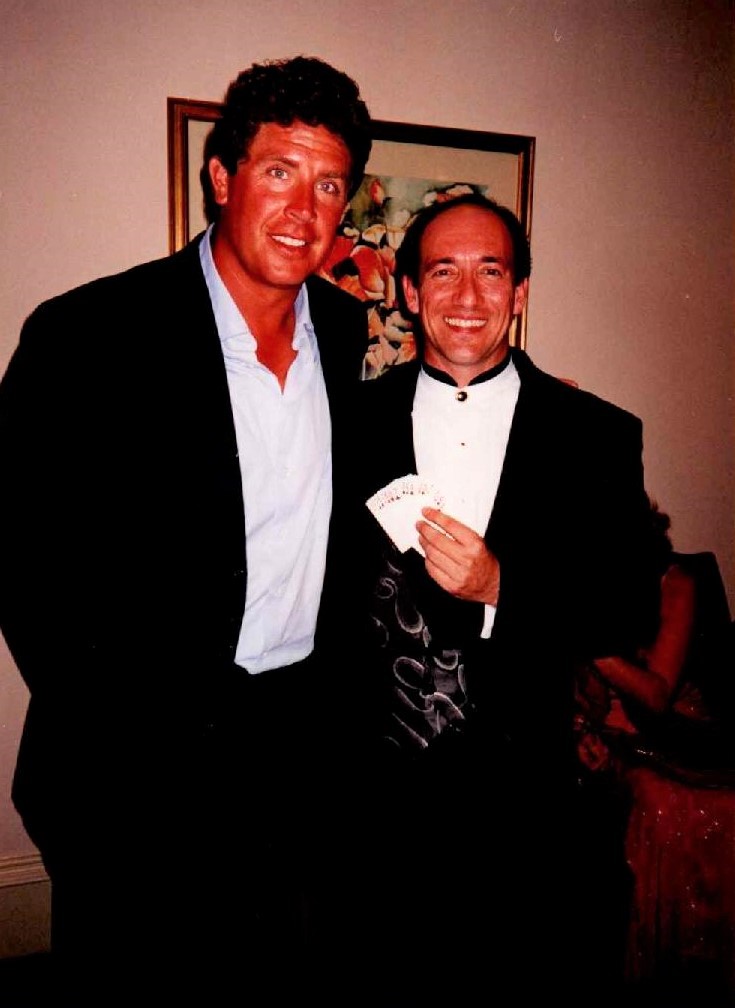
Dan Marino worked his magic to ensure the Dolphins stand alone.
(photo courtesy of Mio Rodriguez)
Perfection, by definition, is impossible to attain for humans. To claim that any achievement is perfect, we have to redefine the meaning of it.
The Miami Dolphins of the 1972-73 season didn’t shut out all of their opponents. Larry Csonka and Mercury Morris didn’t make it to the end zone every time they carried the football. Bob Griese and Earl Morrall didn’t complete every pass they threw. Garo Yepremian’s inexplicable Super Bowl gaffe nearly negated the unprecedented achievements of an entire season.
But within the parameters of a Perfect Season, the Miami Dolphins have set the standard. Seventeen football games, every single one of them ending with a Dolphins victory. The team was as perfect as it needed to be to be called the greatest team in NFL history. Half a century later, no team has been able to meet even that scaled down definition of Perfect.
Two teams have come very close…the 1985 Bears and the 2007 Patriots.
Dan Marino and the Dolphins did their part in turning the 1985 Bears’ campaign into an Almost Perfect Season. Dave Shula was coaching under his father that Monday night at the Orange Bowl. He remembers how electric the atmosphere was, and the strategy they devised to beat a seemingly unbeatable team.
“We had a revolutionary plan that nobody else had tried, and we said, what the hell? Nothing else has worked. Because they were just overpowering people.
“The simple plan was just to put him in the game, Nat Moore, instead of a tight end on first down, and throw the ball. They didn’t substitute and they tried to cover him with Wilbur Marshall, who couldn’t cover Nat Moore. And we put up a big number on them by halftime.
“That was one of the all-time great teams,” Shula remembers with pride, “but they will never be able to say they had the perfect team.”
Of the 2007 Patriots’ campaign that ended with the season’s only loss, Larry Csonka says that he is still the “biggest fan” of Giants head coach Tom Coughlin and quarterback Eli Manning. Even as the unbeaten Patriots were 12-point favorites over the 10-6 Giants in Super Bowl XLII, Mercury Morris could still be seen on TV reminding everyone that “to be undefeated, you got to win every game!”
Manny Fernandez knows better than anyone how the Patriots’ season revived the memories of the Dolphins’ perfect campaign.
“I was actually watching the game with the reporter from the Palm Beach Post. He had come to the house with a cameraman and a sound person, and he was talking to me all through the game and literally putting it on air. Then when the game was over, the local channel that did the Don Shula Show, they sent a crew over to the house at 11 o’clock at night to interview me!”
Dave Shula remembers that his 78-year-old, ultra-competitive to the end father was at the game, and “I remember him saying that he jumped up, and had the smallest measurable vertical jump in the history of vertical jumps.”
Dave worked at Shula’s restaurants for 22 years, and following the improbable Giants victory, “we sent Eli Manning a bunch of gift certificates for he and his offensive linemen to share with their teammates to Shula’s.”
“We’re proud of being the only undefeated team in history,” Fernandez reflects.
“We worked hard to do it.”

Because 50 years ago, a group of guys made Miami a football city.
(photo courtesy of the Miami Dolphins)
It’s impossible to measure what the success of a sports team does for a city, but the 1972 Dolphins gave the Miami community a new point of pride…and it still does today.
Dave Shula remembers his family leaving for Miami from Baltimore when his father was hired away from the Colts. “My classmates had put little paper signs and they hung them in the windows all the way across the classroom that said, basically, ‘Dolphins suck.’”
But the winning coach was most welcome in an area where the only major sports team in the city had only won three games the season before.
“Miami even then being such a melting pot,” his son remembers, “there was nothing that really pulled the people together from the sports scene until the Dolphins in ’70. They started to win, and then continued that in ’71 going to the Super Bowl, and then of course the undefeated season. It really galvanized the community. I remember going to those games as a little guy, how exciting it was going to the Orange Bowl. They were constantly sold out and the fans were just terrific.
“I like to joke that I had a lot of new best friends on Monday morning. I remember a picture that was in the Miami Herald after they won the Super Bowl. There was a whole bunch of people from my school in the background. I think I only recognized one of them, and they were all hugging me like I was their brother. It was funny.”
Csonka remembers a diverse number of age groups in Miami as well as nationalities, who suddenly had a common bond.
“The older ones were enthusiastic fans,” he recalls, “whether they moved down from Buffalo or New England or wherever they moved down from to retire. The young ones, of course, are fired up to be first time champions.
“Those two sections of fans came together as a very, very enthusiastic crowd. If you go back and look in the early 70s when Shula first came, sales and season tickets went up terrifically, and we had sold out situations in the early part of the season in 1970.”
Is Miami represented in all four major sports today without the early 1970s Dolphins proving that the city will very enthusiastically support a winning team?
That’s impossible to answer, but the Rays’ attendance numbers don’t exactly make a strong case to add an NBA team in Tampa Bay. And they were in the World Series not long ago.
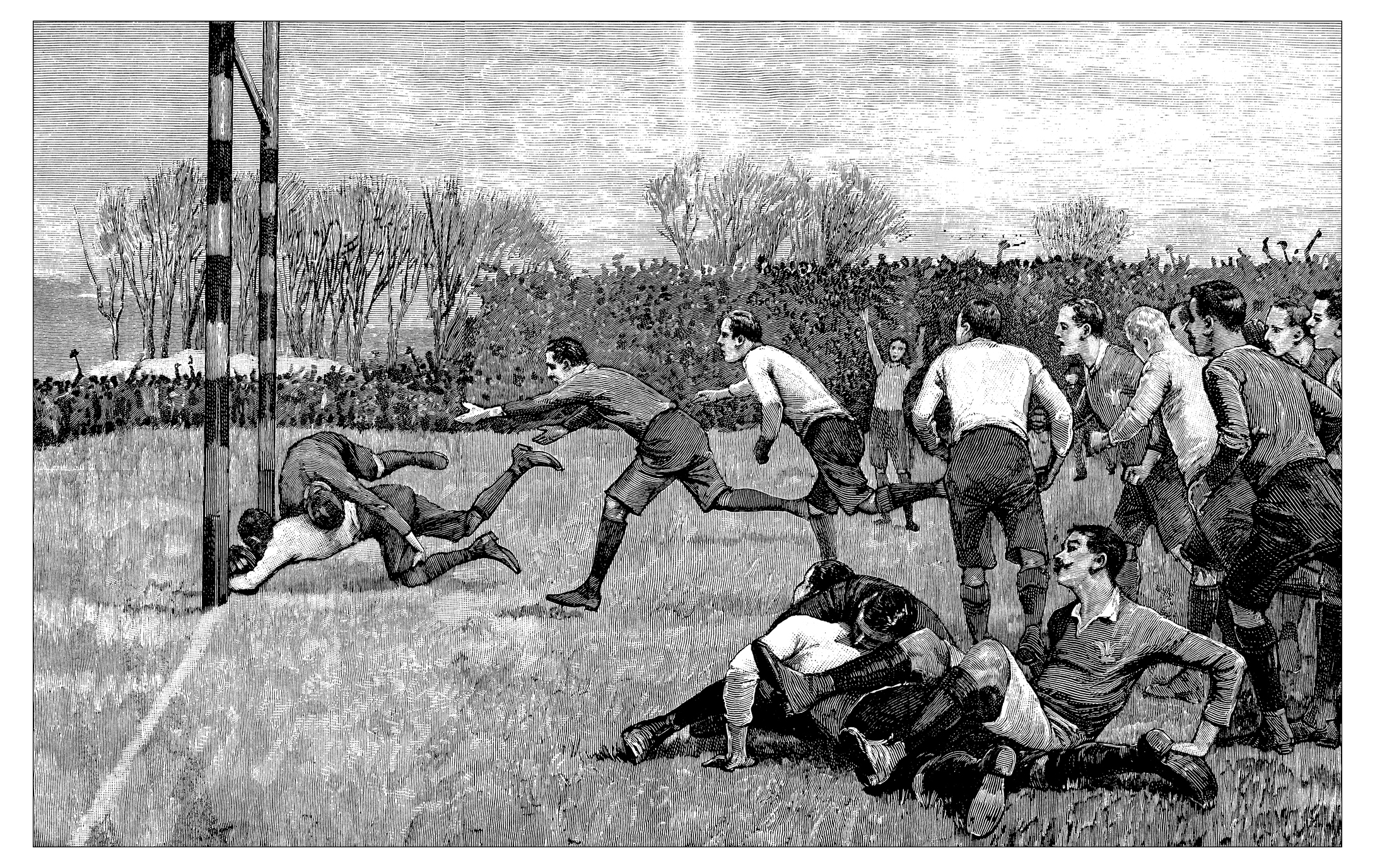
Never in American professional football history.
Manny Fernandez reminded this scribe that it isn’t just the 50 years since that hasn’t produced an unbeaten and untied team. It hasn’t been done by any other team in the 103-year history of the NFL, even when seasons were only eight games long.
Yes, the Dolphins caught some breaks and won games that turned on a single play. And Dan Marino and Eli Manning both played a vital role in keeping the most astounding team achievement in NFL history unmatched in 50 years and counting. Every team that climbs the highest of mountains benefits from some luck.
But in the grand scheme of things, what made the Perfect Season possible was a team full of outstanding players, a brilliant and uncompromising coach, and a truly unified dedication to victory on the part of everyone involved…right down to a punter who was willing to go against his coach and be willing to walk 1,181 miles if it went bad.
A Perfect Season doesn’t turn on one big play. It’s the sum of all of its parts, every player, every play.
As the Miami Dolphins of 1972-73 all know, it’s better to be good than lucky.
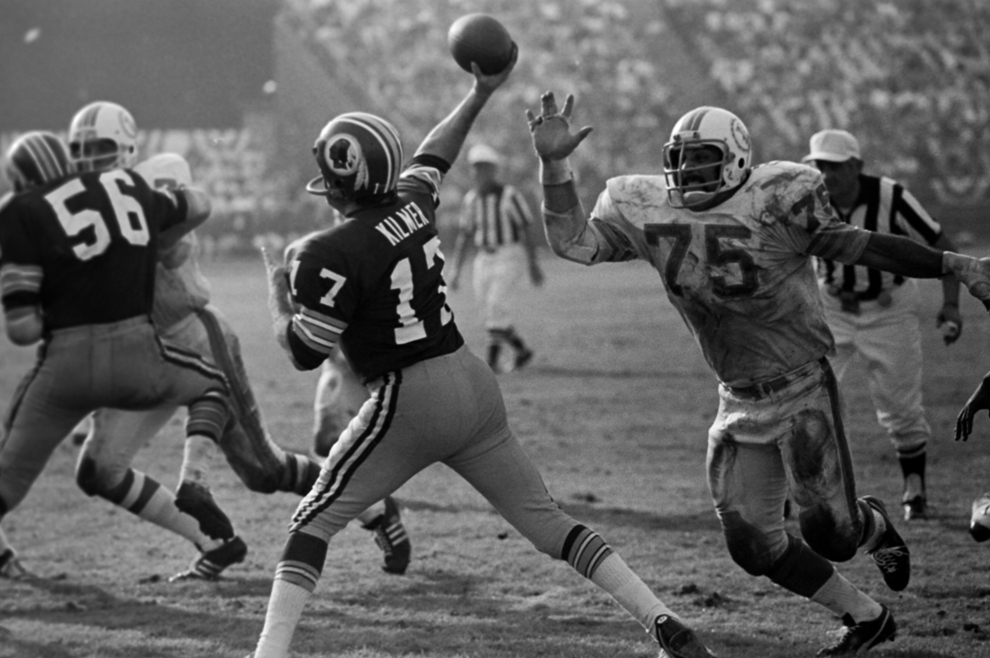
It was never long before Manny was on you.
(photo courtesy of the Miami Dolphins)
Manny Being Manny
Cowboys coach Tom Landry is often credited with the “No Name Defense” appellation given to the 1972 Dolphins defense…a squad that featured Nick Buoniconti, Manny Fernandez, Bill Stanfill, Jake Scott and several others. They led the NFL in fewest points allowed in 1972, and also held Billy Kilmer and the Redskins offense scoreless in the Super Bowl. (Washington’s only touchdown came on a special teams play, famously known as “Garo’s Gaffe”.)
In that game, Manny Fernandez made quite the name for himself, with 11 tackles, six assists and a sack…but the Super Bowl MVP award would go to Jake Scott. Csonka and Buoniconti took issue with the award, believing Scott and Fernandez should have both gotten game balls.
But when asked about the snub, Fernandez says with a chuckle, “We won, didn’t we?”
“I was there to win the game, not get a trophy.”
It turns out he didn’t remember a lot about the end of the game, even at the time. He doesn’t tell the story often, but Manny sustained a head injury late in the game.
“I received a concussion right about either the end of the third quarter or the beginning of the fourth quarter. It was a swing pass to Larry Brown. I made the tackle, got him by the jersey, swung him around, and as we swung down to the ground, Nick came in to finish him off and got me right in the temple.
“I played out the game, but I don’t remember any of it. I don’t remember that night, the celebration. Woke up in the morning, I had to ask my wife if we won.”
It’s easy to call Fernandez a big game player…his Super Bowl totals include three sacks and 28 tackles in three appearances on football’s biggest stage. But as Dolphins fans knew, those types of performances were just Manny being Manny.
Fernandez recorded 35 sacks in his eight year career, with 4 1/2 sacks in the postseason. He was a second team All-Pro twice, a second team All-AFC selection twice, and an All-AFC selection once. The Dolphins wouldn’t likely have won back to back Super Bowls without Manny Fernandez pummeling offensive linemen…and his desire made him a perfect fit for Don Shula’s design of a championship team.
“I came into Miami as an undrafted free agent, more or less an afterthought. The entire first week, I did not practice one play. Did all the warmups, did all the work on the machines, the tackling dummies, did all the dummy stuff. I never got on the field until Friday morning.
“Jim Urbanek, number one draft pick, defensive tackle, blew his knee. They put in another number five draft pick from Alabama, and he blew his knee. Coach (Les) Bingaman, our defensive line coach, came over and said, any of you think you can play this game?
“I just looked at him, I said, you’re g**damn right if you give me a chance. He said, okay, Mexican, see what you can do. I went into that scrimmage, bound and determined that I was going to make a name for myself. I was going to make that football team. And I did.
“I started every game from then on.”
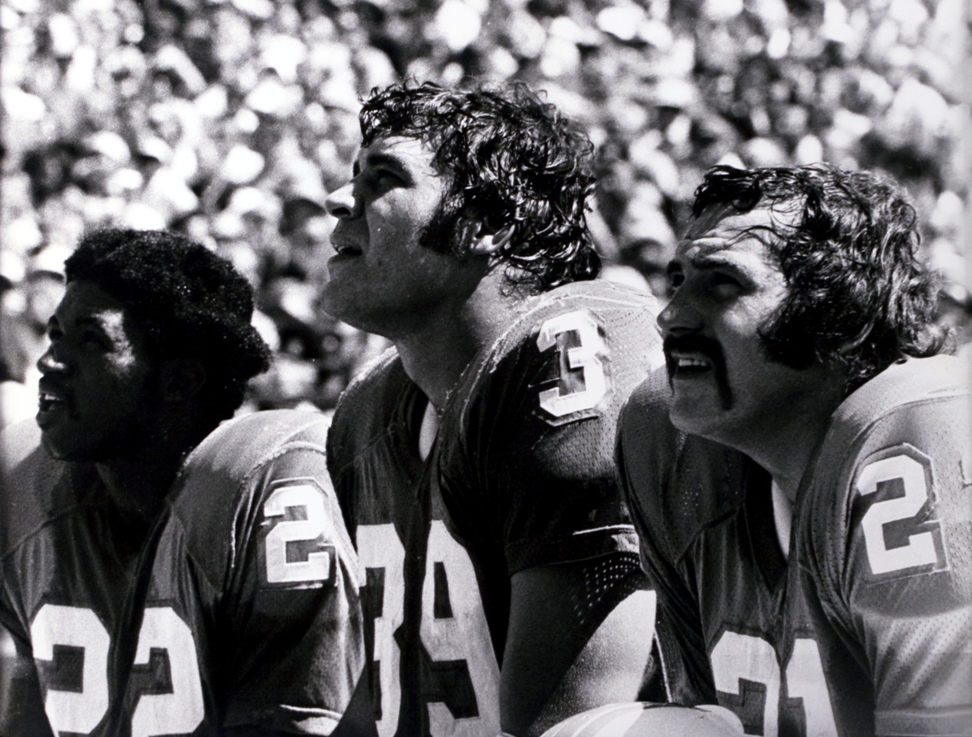
Three true team players.
(photo courtesy of the Miami Dolphins)
The Interchangeable Backfield
There are many stories of members of this team being willing to sacrifice their own personal achievements for the team, but the best example is easily Jim Kiick and Mercury Morris, who split running back duties throughout the season…Kiick as more of a blocking back for Csonka, and Morris as more of a runner who could get to the outside fast.
The younger Shula cites his father’s handling of the Kiick and Morris situation as an example of how the coach set the tone of playing for the team first.
“The story goes that either Jim or Mercury would be in my Dad’s office on Monday, and it was the one that didn’t get to play much the day before. He knew that they needed to vent their frustration because of their competitiveness.
Dave Shula speaks not just as Don Shula’s son, but as a former NFL coach himself. “It’s hard to do that, to keep your star players that aren’t getting the ball as much as they think they should, to keep them content and keep them working toward the goal of helping the team win.”
Csonka remembers the camaraderie between Kiick and Morris, even as the few shared the spotlight in the Miami backfield.
“You’d see Jim run off the field, Merc would be running on, and they’d smack hands as they passed each other. Jim only ever bitched one time. We were close to our own end zone, and it was a 40-yard sprint with the bench, and he didn’t like that part. He didn’t want to run 40 yards to the bench and 40 yards back!”
Csonka remembers the moment with a laugh, but as a Hall of Famer who played for winning and losing teams in his career, he knows how it could have turned out had Kiick or Morris not been on board.
“If you don’t have that,” Zonk says of the two players’ mutual respect, “if you have animosity that builds, it’s like a cancer on the team. It’ll start between two players, and it’ll carve up the team before it’s over.
“But Shula made such a strong case of everyone being disciplined to the fact that winning became more important than personalities or number of carries or any of those other things.”
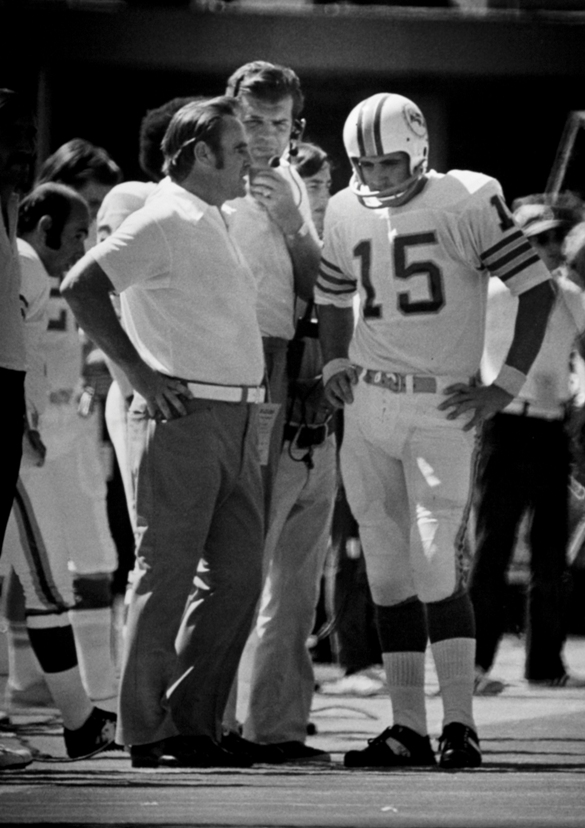
“Get ready to shed your placeholder status, Earl.”
(photo courtesy of the Miami Dolphins)
“Weak Schedule” vs. “Backup Quarterback”
It’s been noted by sportswriters and non-Dolphins fans that the 1972 Dolphins benefited from a weak schedule, and the claim isn’t entirely without merit…only two of the teams the Dolphins defeated during the season had winning records.
But if someone brings that argument up with you, remind them that the Dolphins also lost their Hall of Fame quarterback in the fifth game of the season, and proceeded to win nine games and a playoff game with a backup quarterback. It’s doubtful the 2007 Patriots could have pulled that one off.
Backup QB Earl Morrall is one of the 1972 Dolphins’ biggest heroes. Following Bob Griese’s ankle injury, Morrall took over and kept the train rolling. He threw for 1,360 yards and 11 touchdowns in nine games, and then led the team to a victory in the Divisional Round playoff game against the Browns.
But most importantly, after bringing the Dolphins to the dance, in the AFC Championship game Morrall went back to the bench and let Griese finish the job without complaining. Like everyone else on the team, he had made his vital contribution to the Perfect Season.
In his book, The Winning Edge, Don Shula tells the story of convincing Dolphins owner Joe Robbie to pick up Morrall to back up Griese. Morrall had been the backup for Johnny Unitas and had performed a similar feat in Baltimore, leading the Colts…coached by Shula…to a Super Bowl as a backup before their infamous loss to the Jets in Super Bowl III.
The Dolphins, being the AFC champions at the time, had the second to last chance to claim Morrall when the Colts placed him on waivers, but the rest of the NFL passed on a backup QB who would make history starting and winning nine games of a Perfect Season.
Shula recalled the moment when he decided to switch back to Griese to start the second half of the AFC Championship game against the Steelers.
“What I had to tell him was hard. He had done the job all season long and I was appreciative beyond words. But I had to do what was best for the team.”
In the brief conversation they had, Morrall immediately accepted the decision and informed Shula, “If you need me I’ll be ready.”
If anyone exemplifies what it takes for a team to achieve a Perfect Season, it’s Earl Morrall. Who was Tom Brady’s backup in 2007 again?

Eagles Tailgating: The Greatest Party in Greater Philadelphia
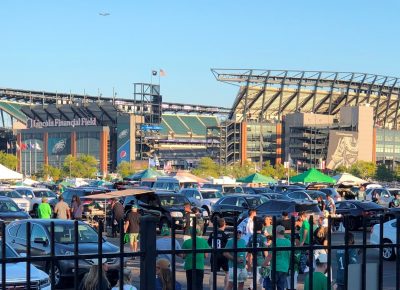
There is no gathering anywhere in the region like an Eagles tailgate. (Published for the Fall 2023 issue of PhillyMan…see the magazine article here.)
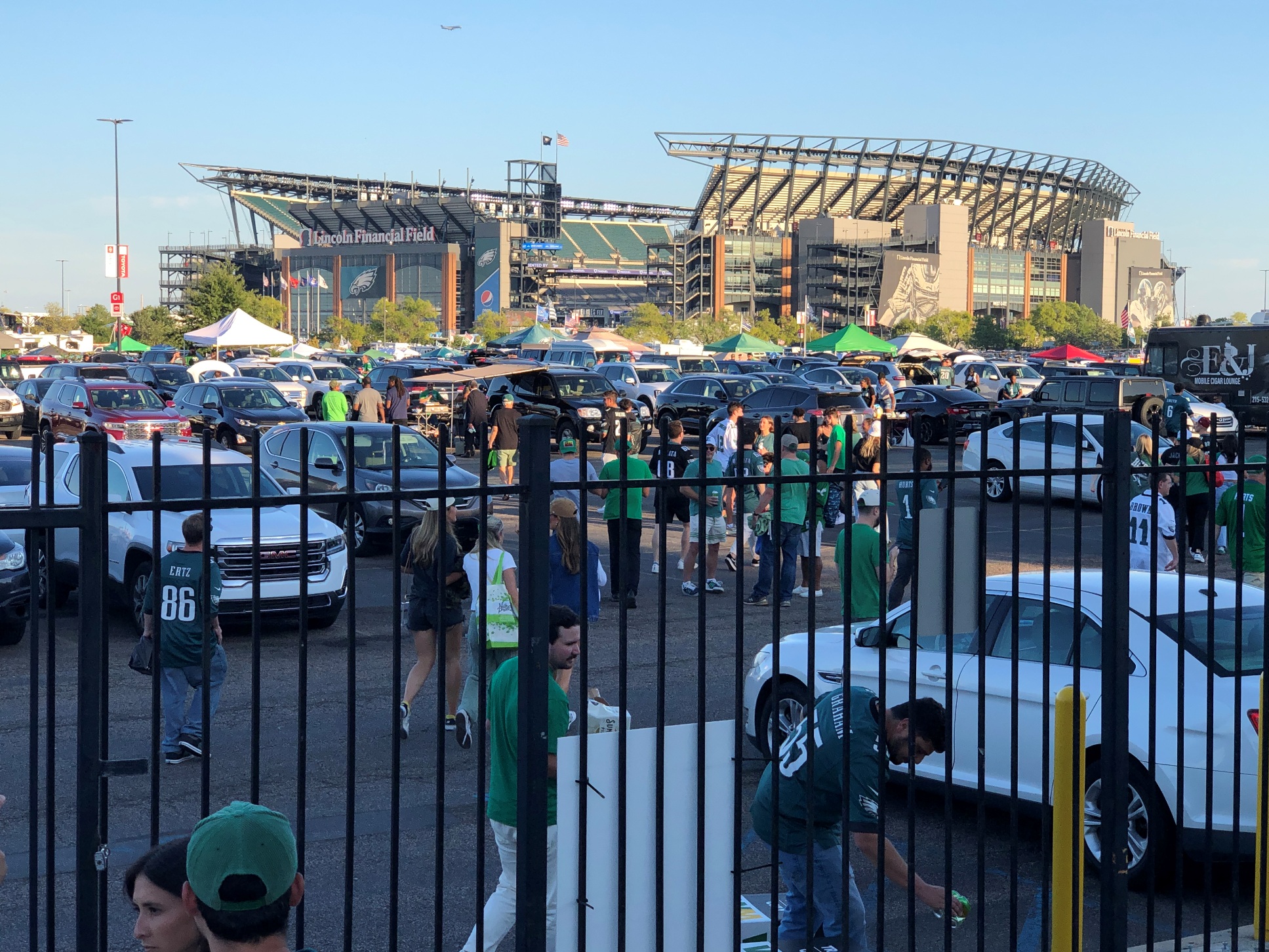
Most of the thousands clad in green at the party on Pattison probably don’t even realize it, but there is a truly special element to being in the parking lot on Eagles game day.
It’s that no matter your political persuasion, your religious denomination, your ancestral roots or your musical taste, you have something in common with the stranger next to you. In the parking lots surrounding Lincoln Financial Field on game day, everyone bleeds green and shows their commitment. On Game Day, the Birds are the only thing that matters to anyone.
Tailgating, at first glance, seems an alternative to paying the eternally brazen “atmosphere fee” for food and libations inside a sports venue. But when the party encompasses more than a square mile and looks like this, its purpose goes well beyond thrift. To call an Eagles tailgate a party, to even call it a celebration, is a rank understatement.
Throughout the lots at the home of the Eagles, including those meant for other teams who happen to play here, you can walk in any direction and see buses, campers, trucks and vans…the majority of them covered with artwork that would provoke a double take on the highway. It gives one pause to consider how much of a fan one must be to shell out the kind of coin needed to decorate a vehicle so magnificently.
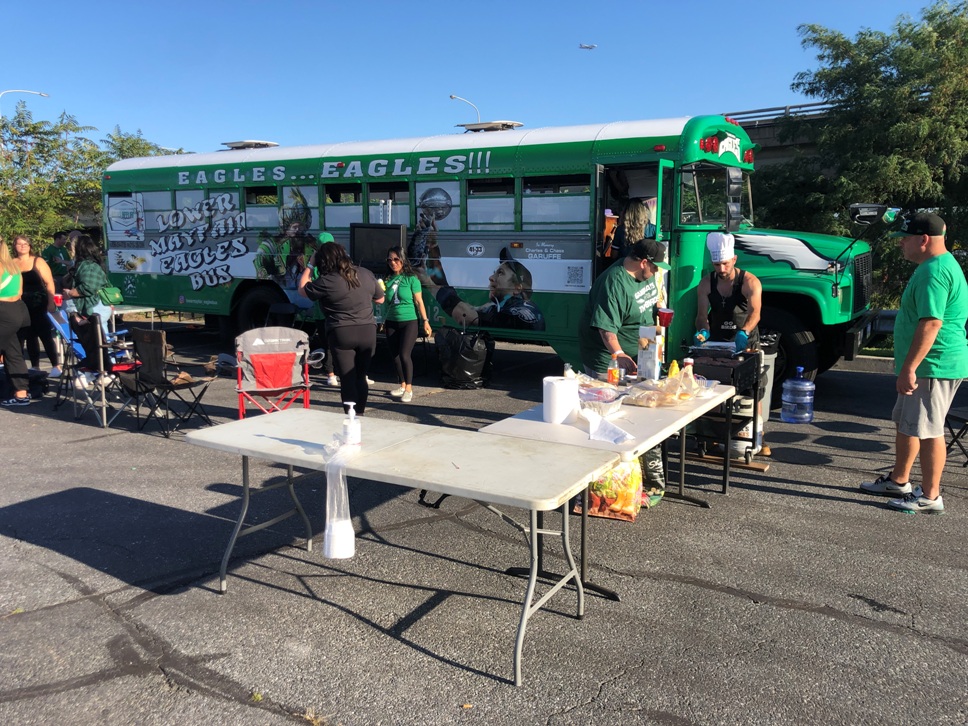
After a long day of painting a bus, it’s time for a drink.
Everywhere in this mammoth block party, one hears loud music from a variety of styles and eras. Everywhere, you can smell coal, sausages, burgers, and yes, frequent whiffs of reefer. And anywhere you happen to be, you won’t often go five minutes without hearing an Eagles cheer…usually begun by one person, which easily gets at least a dozen more to join in.
If you’ve never been a part of tailgating at this level, you’ll be truly amazed at the dedication of a large number of participants. The seasoned pros arrive early…as much as six to eight hours before game time. (Do the math of how early you’d have to get out of bed, on a cold November Sunday morning, to tailgate for a 1:00 game.)
Veterans of Eagles tailgating even have their designated parking spots, that they head directly to when the gates open…for various reasons, such as being near a grate that can be used as a bathroom. True.
You can easily spot the amateurs…the late arrivals. They spend far too much time in an agonizingly slow quest…not only to find an open spot, but to work their way into it as carefully as possible to avoid gazebos, coolers, and equipment that other tailgaters have established hours before.
Hopefully they’ve learned their lesson from the experience…you need to take this party a heretofore unheard of other level of seriously.
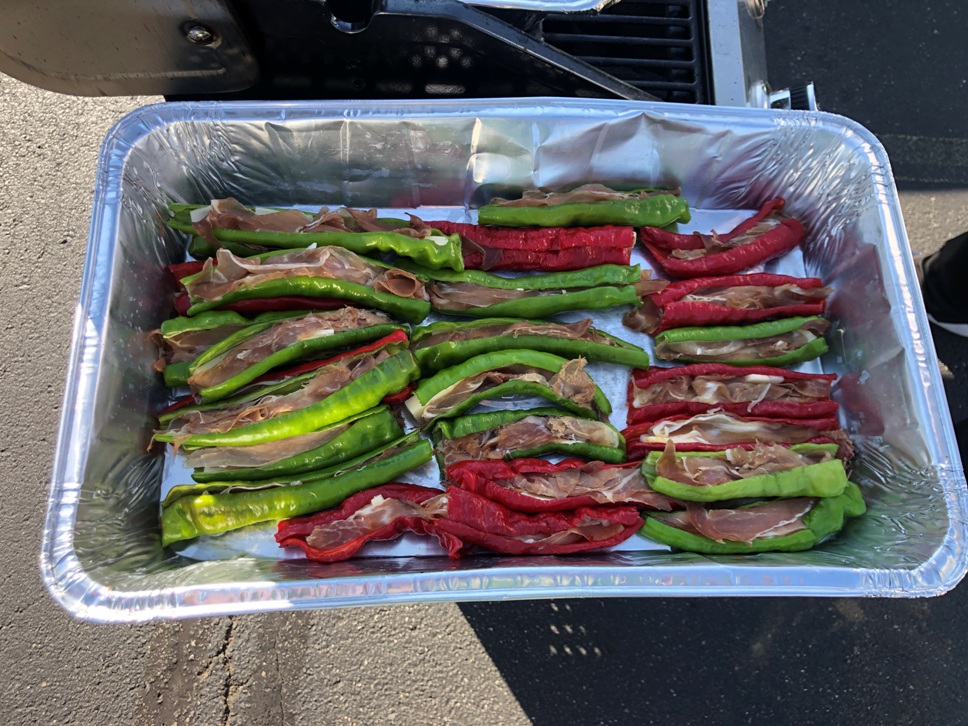
Dan Kukral’s stuffed long hots are reason enough to be part of the Danny Burke tailgate on game day.
Dan Kukral is the head chef of the Danny Burke tailgate, named for his brother-in-law who runs much of the party. He was given the chef’s role, he says, because “I come up with all the fun ideas for food.”
Kukral is a research scientist at a pharmaceutical company, which is remarkable given what you’re about to read about his contribution to game day.
He and Burke usually begin the party preparation about five to six days before game day (yes, you read that right). Once they’ve gathered food and supplies for a party that can be for as many as 200-300 people and brought it all to the Linc, he takes on the sizable cooking duties.
Needless to say, it’s a lot for one guy. Kukral simultaneously looks after the preparation of ribs, pulled pork, shrimp and sausage bayou, Buffalo chicken dip, and of course, dogs, burgers, wings, sausages with peppers and onions…even long hots with stuffed provolone and prosciutto. As anyone can easily see from the hefty, mouth-watering piles of grub, he’s more than up to the challenge.
It’s all a labor of love, he says. No kidding…a system as efficient as this doesn’t happen casually. The Danny Burke folks get contributions from participants, which covers the food and drink, but he doesn’t get paid for his more than considerable efforts.
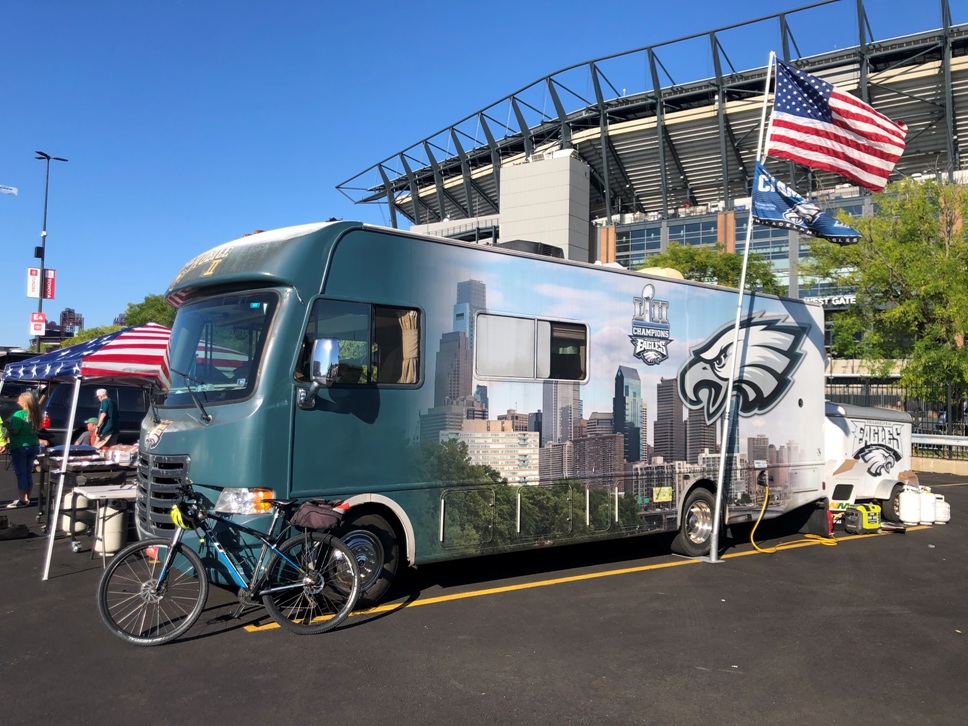
If you think this pain job is impressive, check out the back.
Kukral is just one of many for whom Eagles fandom is a passion worth the investment of time and money.
This observer also spoke with Ed Callahan, whose camper has occupied a spot in the Wells Fargo Center lot since the opening of Lincoln Financial Field. Ed tells an amusing story of why he and his crew acquired a camper.
“In 2004,” he recalls, “I went to a road trip game in Cleveland. There were four of us, and we parked in the lot next to a beat-up old RV. For a swap of a cheesesteak, the guy who owned the RV let us use the bathroom.”
An even trade, certainly. But bringing a bathroom to a tailgate, they realized, was a super idea, for obvious reasons.
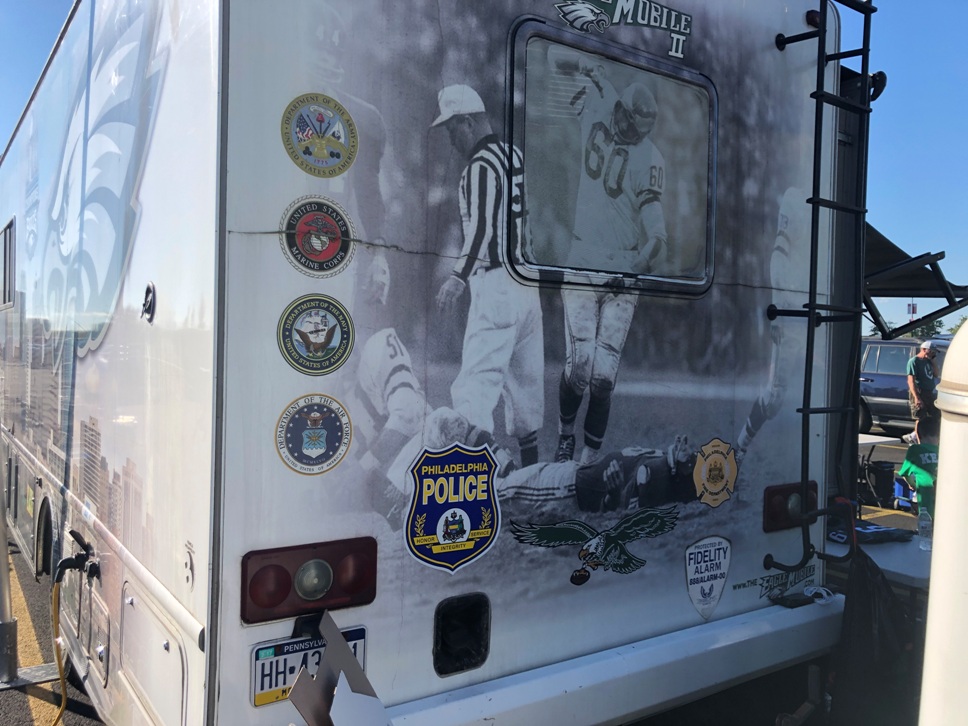
“I’ll knock the loyalty to Kathie Lee right out of you!!”
Ed and his crew bought an old RV, fixed it up, and made it a staple of the parking lot. They eventually had to replace it following a wreck, so they’ve upgraded to a new one.
Callahan’s current camper is a thing of beauty to behold for a Philadelphia football fan, and it might be the most artfully decorated vehicle at the Eagles tailgate…which is undeniably saying something. The back of the RV is adorned with a large scale timeless image of Frank Gifford lying motionless on the field, following the epic Chuck Bednarik hit. On the side is a wide panorama skyline shot of our city, ranging from 30th Street Station to Billy Penn’s statue.
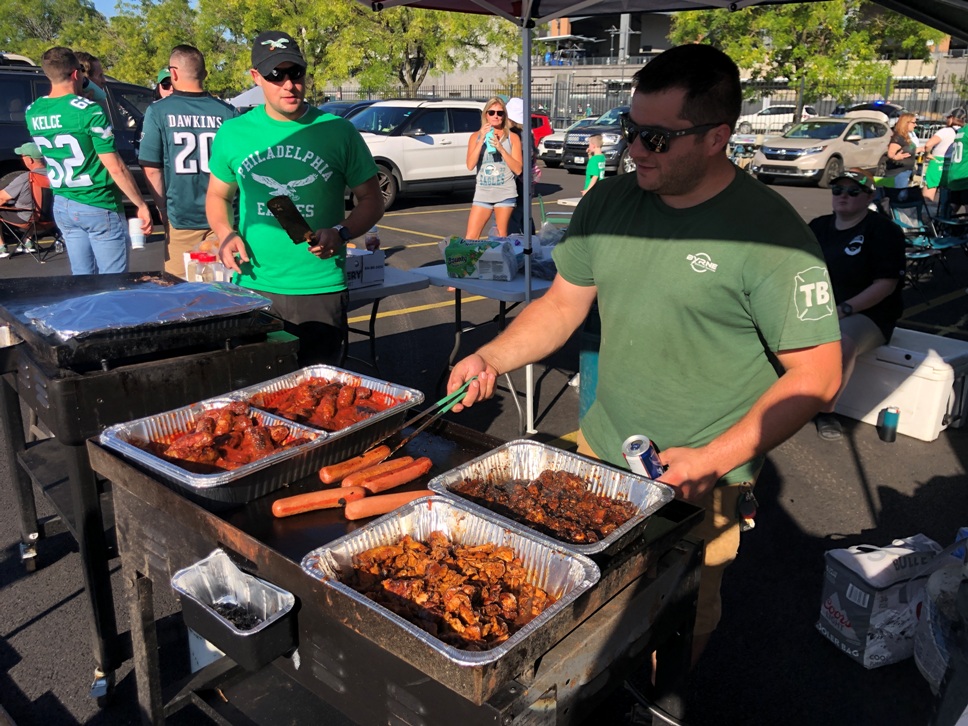
Anthony is the right man for the job.
The cook of Callahan’s crew is a gentleman named Anthony. Anthony is definitely keeping busy looking after sausages and other comestibles. He estimates that their party serves anywhere from 30-100 fans each home game.
Executing a successful tailgate, Anthony says, is a full-time job. “All week, getting food together, cleaning the RV, getting all the grills, utensils, tables, and all that. It’s a full day…breakfast, lunch and dinner in the parking lot.”
Ed says their breakfast specialty is an Irish American Philly Omelet… made with imported Kerrygold cheese from Ireland, Cooper brand American cheese, and Philadelphia cream cheese, all in a three egg concoction.
There might be a few NFL cities that are in Philadelphia’s universe when it comes to the magnitude of the pre-game party. But there is one thing that The City of Brotherly Love offers that is unique: cheesesteaks, scrapple and pork roll.
Buffalo can keep their wings, December weather, and four straight Bowl defeats.
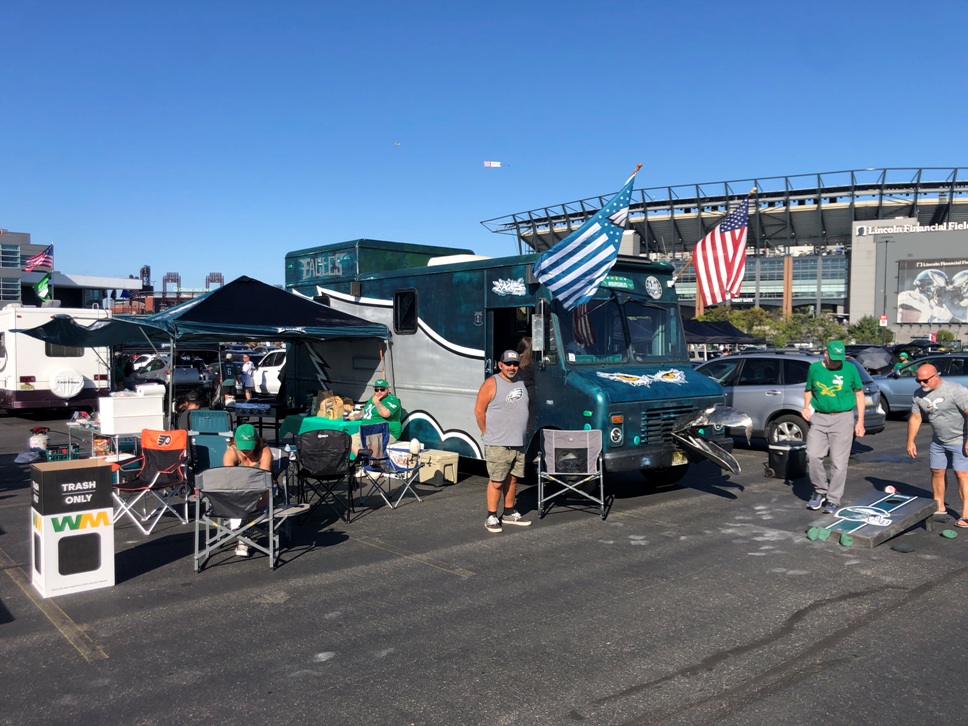
These people need a lot of stuff.
To witness football fan dedication of this level brings to mind a whole world of entrepreneurial opportunities for local businesses. Incidentally, our friends at Duck Donuts realized this…on the day this article was written, the author received an email with a subject line that read: “Win The Tailgate With Donuts!” They get it.
Sure, for liquor stores, sandwich shops and food markets in the area, it’s obvious. Put it in your promotional materials that you offer everything Eagles fans need for Game Day…cases of beer, large bottles of liquor and mixers. Ready-made subs and pizzas, bulk packages of burgers, sausages, chips, dips, and rolls.
But that’s just scratching the surface. A party this size needs it all.
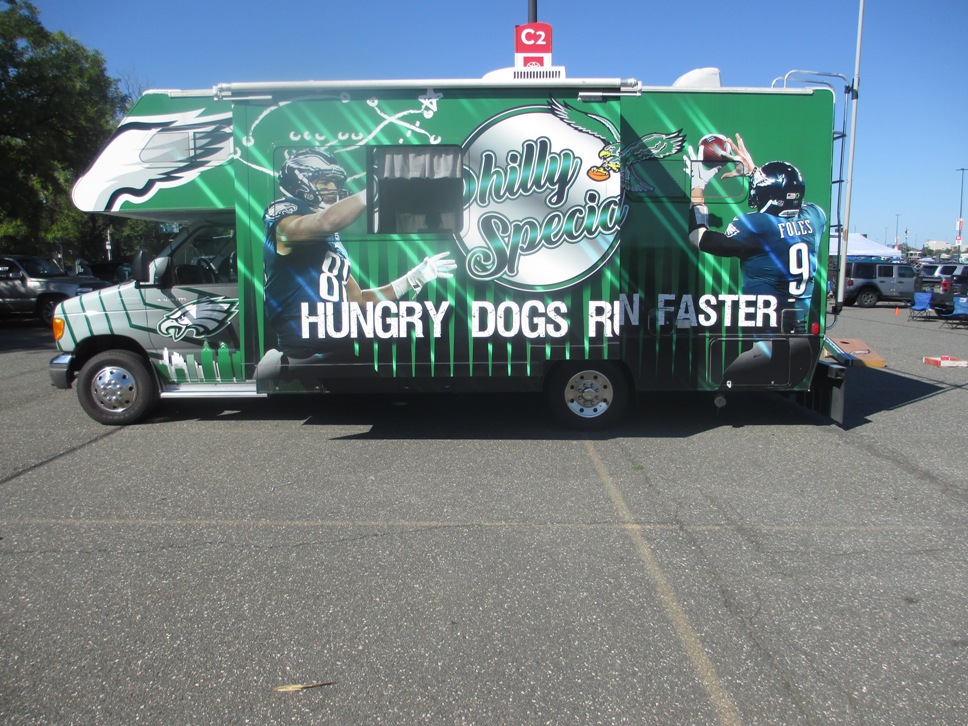
“Say, who painted your RV?”
An owner of an RV dealership can add a bar and lounge to the inside of a used camper to make a sale to a dedicated Eagles supporter. Vehicle wrapping and decorating outfits could market their wares to fanatics that buy multiple spots at considerable cost for their RV.
Needless to say, anyone selling Eagles gear could market to the block party…most all of whom represent their team faithfully with jerseys, caps, face paint or any kind of accessories featuring the Eagles logo and colors.
Outdoor stores could make a serious profit too. Grills, propane tanks, coolers, generators, portable toilets, anything associated with RV adventures might be applicable to a tailgating demographic. Space heaters and fuel would undoubtedly be in big demand in the colder months. Decorating anything with the Eagles colors and logo could make the sale to the typical Linc lot enthusiast.
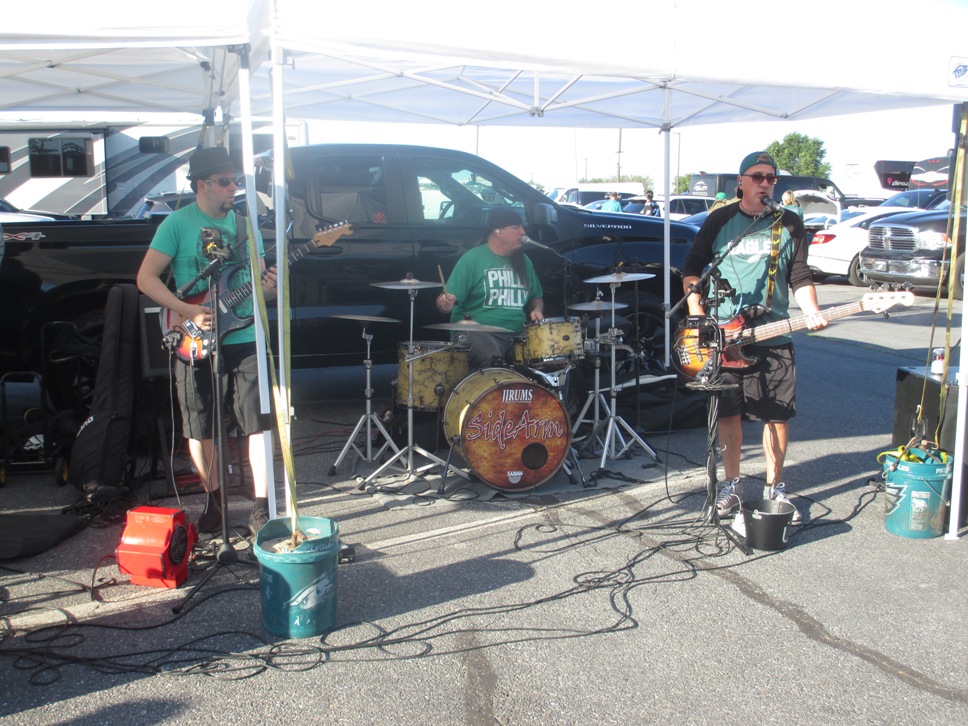
This band was playing Van Halen’s “Unchained”, and the guitar player handled himself quite well. It’s no place for amateurs.
It’s even an opportunity for catering services, private event coordinators, DJs, even live musicians, all of which you can easily find at an Eagles tailgate.
If nothing else, fly a plane towing a banner over it all for the thousands in the lot to see…which also happens frequently.
You get the idea, but even if you’re a realtor or a financial advisor, there’s no reason why you can’t build goodwill by renting a camper, hosting a game day party and inviting your customers, as one business owner (who asked for her name not to be shared) does.
No doubt, your Eagles fan patrons will speak well of you.
Because after all, you’re family.
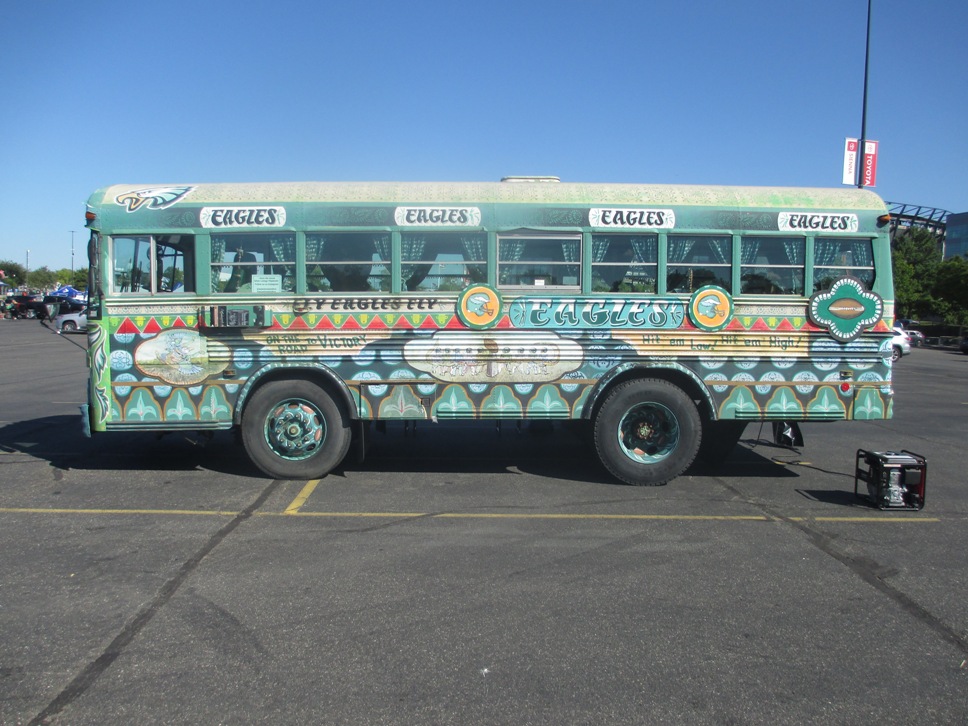
As seen on the movie screen!
As Seen In The Movies: The Silver Linings Playbook Eagles Bus
If you’ve ever seen the movie Silver Linings Playbook…and if you’re a Philadelphian, you should…you likely remember the scene where the Eagles-decorated “Asian Invasion” bus shows up in the Linc’s parking lot on game day.
In the scene, protagonist Pat Solitano Jr., has just been released from a mental health facility for bipolar disorder. At the game, he notices that his therapist, Dr. Cliff Patel, has emerged from the bus.
He catches up with Patel…whose face is painted green and silver…and Patel dispels any concerns about their meeting outside of the facility: “Today, I’m your brother in green, not your therapist.” Soon, the two have a discussion with Pat’s friend about what the Eagles strategy for the game should be, punctuated with hilarious foul language.
After the movie was made, no one really knew what to do with the bus, and so a movie hand decided to sell it on Craigslist.
Bill Curley, a long, long time veteran of Eagles tailgates, went for it, and today the Asian Invasion bus is parked in the Wells Fargo lot for every Eagles home game.
“One of the people working on the movie ended up with the bus, and nobody wanted it,” Curley remembers. “The Inquirer wrote an article about how the bus was for sale prior to the Super Bowl. Once they won it, I called the guy on the phone and said, ‘hey is the bus for sale?’ and he said yes.”
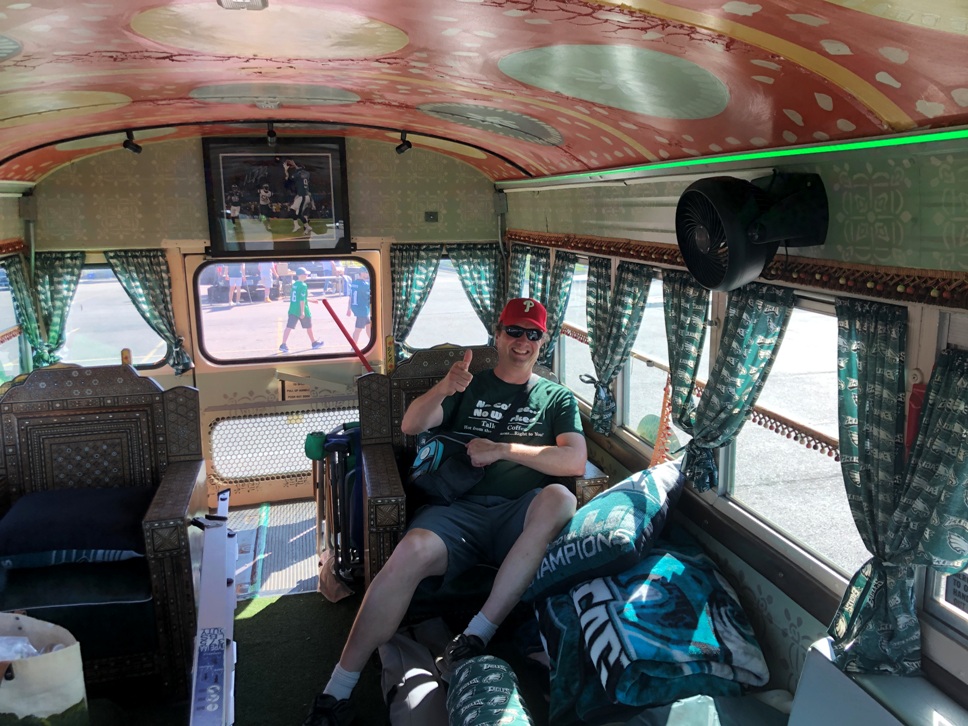
The author of A Great Number of Things enjoys some time in the Asian Invasion bus.
Curley bought the bus for $9,000 in 2017. He estimates that he’s put a total of $30,000 into the investment. The bus is comfortably remodeled inside, with cushioned benches and Eagles decorated chairs, offering a spot to escape weather that can be trying in this part of the world any time of year.
“I come here early and park right here at the end, so people can take pictures. It attracts people from all over the country, I’ve had several people from Canada. A lot of ‘this is my first game, I’m from Utah, it was a birthday gift,’ they come and introduce themselves. It’s a neat thing.”
He still gets into the party, showing up early, saving spots for family and friends, and cooking sausage and peppers for whoever shows up. He was at the Linc at 11:30 AM for the Thursday evening home opener. “It starts early and it ends late,” he laughs. “My daughter’s coming today with her friends.
“This isn’t the most comfortable thing to drive in traffic, so I leave early.”
If you’d like to see the movie scene, you can search for “Silver Lining Playbook Eagles Tailgate Scene” on YouTube. And the next time you’re at an Eagles home game, check out the Asian Invasion bus…it’s well worth a look.
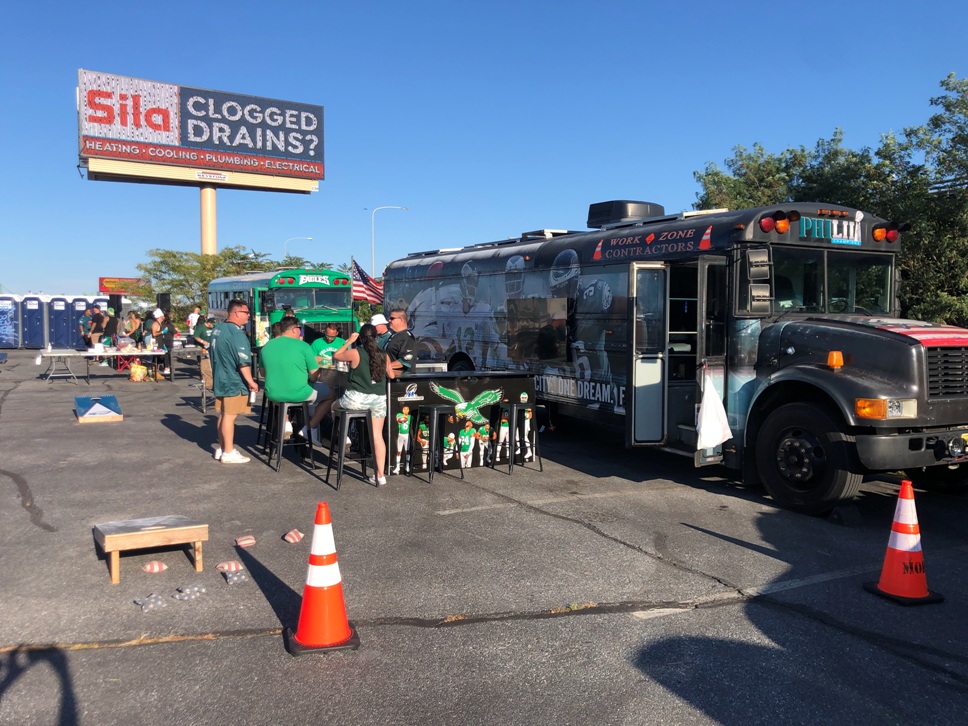
They mean it in the Jetro lot.
The Jetro Lot
While the Eagles tailgating scene is a thing to behold throughout all of the parking lots, some lots are at a different level of enthusiasm than others, and the parking lots at the Jetro Warehouse east of the Linc are undoubtedly the wildest.
To Philadelphians, the name “Jetro” is probably more known for what takes place in their parking lots than for what they do…they are a wholesale restaurant supplier, selling catering supplies and food preparation equipment to caterers and restaurant owners throughout the region.
But it’s likely that their most important…and maybe profitable…contribution to the city is their ample amount of parking spaces in the Sports Complex. The Jetro folks are, needless to say, aware of this, and they even have Facebook and Twitter pages dedicated expressly to their parking offerings for Philly sports events.
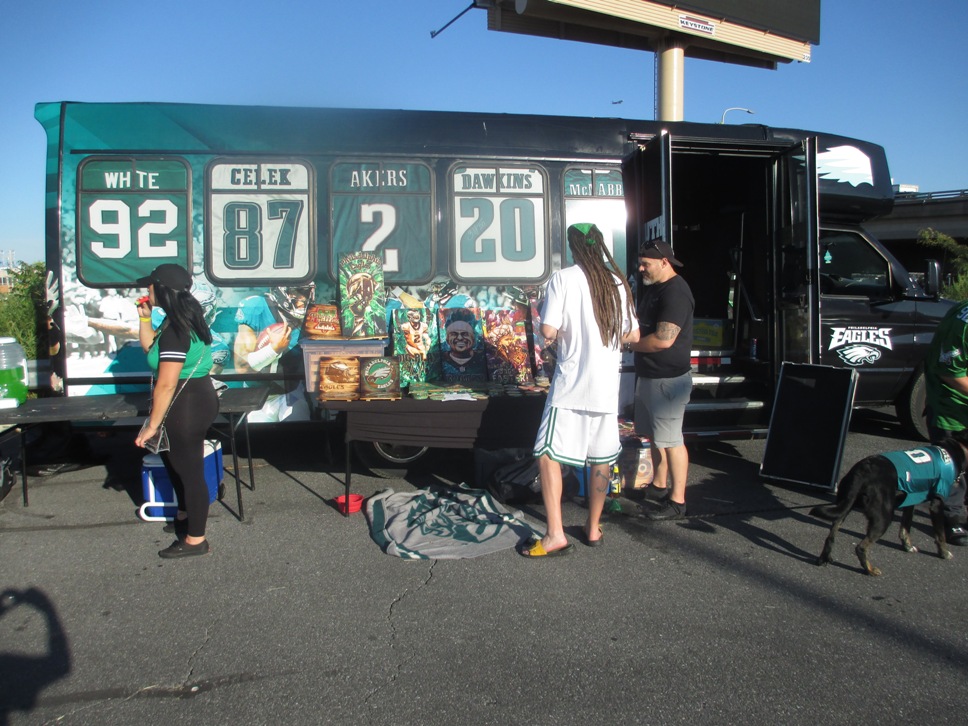
The art stylings of Jonathan Metz.
The most serious of Philly tailgaters seem to congregate at Jetro. In this observer’s visit, just a small sampling of things to see were a large number of beautifully decorated buses, a gentleman by the name of Jonathan Metz selling superbly Eagles-themed woodworks, coasters and other items, and a live band whose guitar player could mimic Eddie Van Halen’s licks quite well. That’s a ridiculously small sample, but magazines have space limits.
Jetro’s lot isn’t a place where you’d want to bring the kids or your church group. It’s loud and raucous, with music that often features lyrics full of f-bombs. There’s also a few flags that are openly critical of the current occupant of the White House, and not in a polite way.
But if you can handle that, and you truly want to show your Eagles fan dedication, the Jetro lot is likely the destination for you. It’s well worth a visit, if only just to see the level of fandom the local football team inspires.

It’s A Dog’s Life – Animal Aid USA
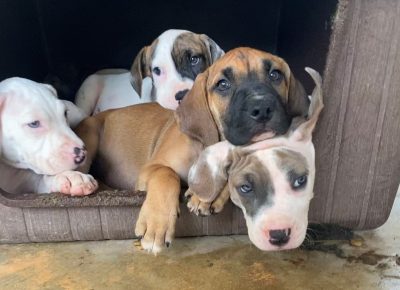
The volunteers at Animal Aid USA take a trip to rural Georgia every four weeks, to rescue stray and abandoned dogs and give them a home. To date they have rescued 40,000 dogs from unimaginable conditions. This story appeared in the spring 2023 issue of JerseyMan, you can read the magazine version here.

You want to give them names already, don’t you? (photo courtesy of Karen Talbot)
It’s A Dog’s Life
Our canine friends teach us one of the most important lessons of life: it’s too short for anything less than unconditional love, compassion and forgiveness, all the time.
Karen Talbot, Rachel Monaghan and the volunteers at Animal Aid USA have taken that lesson to heart. Their mission is to return the favor of unconditional love, to as many dogs as possible.
As anyone who participates in their rescue caravans can tell you, it’s a big challenge. Talbot herself says it’s not for everyone. “It’s grueling on that road.”
Animal Aid USA gathers volunteers, vehicles, water bowls, blankets, crates, and whatever else is needed, for a trip to rural Georgia from Williamstown every 28 days. They then gather abandoned dogs from local shelters in the area, load the dogs into vehicles, and take a 16-hour overnight drive back to New Jersey, to place dogs with no-kill shelters to be adopted.
A 64-word paragraph can’t begin to capture the level of effort involved in the operation. Monaghan, a regular volunteer, describes the process:
“We leave at 6:00 at night and arrive in Georgia around 9:00 AM the next day,” she explains. “Once we get down there, we prepare our vans with water bowls and line all our crates. If we have litters of puppies in our vans, we’ll extra line the crates, because we have to usually change them while we’re driving.
“That’s usually on a Thursday. Friday is when we do all of our preparation. In the morning, we’ll clean kennels again, and then we prepare for transport. We usually have about 30 crates in each van, we put in puppy pads and towels or blankets in all the crates. Karen tags them all, so we know which dogs are gonna be in our van. We prepare extra water bowls, extra towels and stuff to clean up any messes that happen.”
“At around 4:00, we start the load, we’re out of there by 5:15. Everyone’s just going in every direction. It’s like all hands on deck.”
Talbot, who spends much of her life preparing for the trips, likens it to a Broadway production.
“All of the preparation and the dress rehearsals and everything that you have to do lead up to one moment, and that one moment is “It’s load-up time”. That’s when everything has to be done done done, because the first dog in is gonna be in there the longest, and it’s all about getting them all in the right crates, and making sure everybody fits.
“Once they’re all in, we do our giant prayer circle and we’re off.”
The crew of vehicles with its precious cargo, including the rig mostly driven by Talbot’s husband Dante, then drives through the night…the only time D.C. traffic on I-95 is avoidable…back to New Jersey, where dogs are unloaded and placed with Animal Aid USA’s adoption partners. The project is both exhilarating and exhausting.
“Then you get home and you crash,” Monaghan laughs.
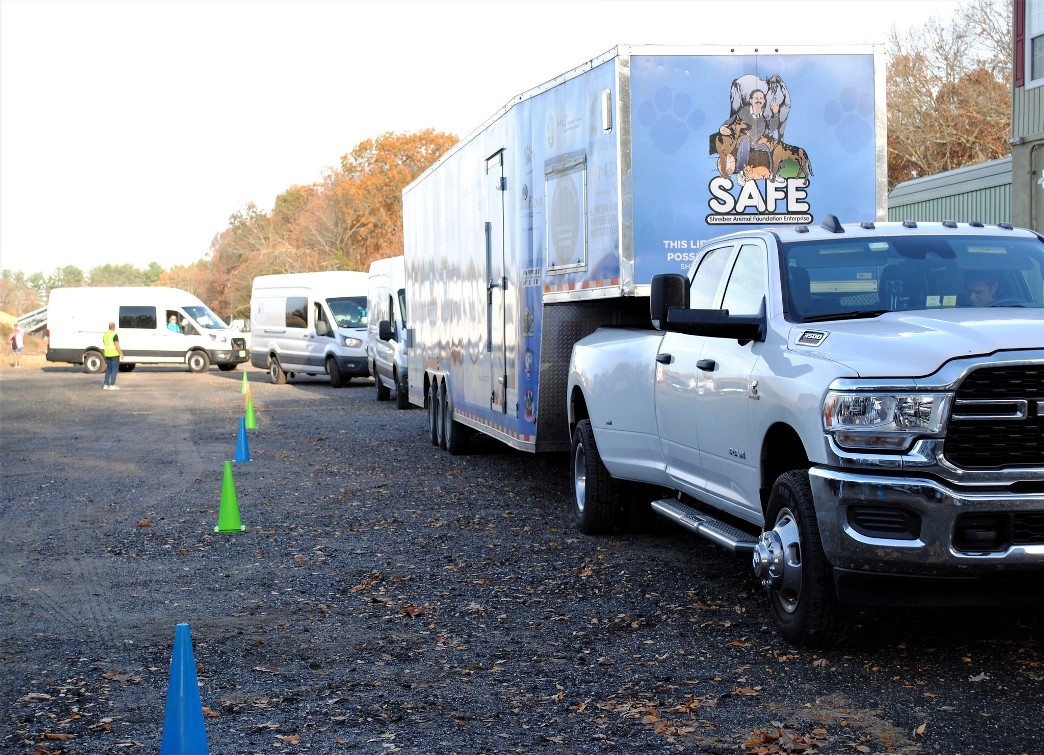
A truck full of dogs headed to be adopted in NJ. (photo courtesy of Karen Talbot)
So why rural Georgia, 16 hours away, every four weeks? Surely there are plenty of stray and abandoned animals in New Jersey?
Probably. But in Georgia and several other states, many rural counties don’t have the resources to care for stray dogs. Sadly, it isn’t often even for a lack of funding. There’s simply a different attitude towards dogs in the places where the caravan goes.
It was quite the culture shock for Talbot, as it would be for any animal lover.
“Animals are not viewed the way they are up here,” she says. “They’re not household pets, they’re not family members. They are yard dogs, they’re a nuisance.
“They don’t have the same empathy and compassion. The majority of people could care less about animals, and the minority of animal lovers are really fighting a bad war.”
She remembers witnessing how the situation reaches a tragically mind-numbing level for many people.
“When I first started going, I was so angry with them at first. Like, ‘Wait a second, you mean to tell me that you love animals, but you drove past a litter of puppies on the side of the road? What the hell kind of an animal lover are you?’
“But as I got to know these people, I realized they have 40 dogs at their house because they stopped 40 times, and now they can’t feed their families, now they don’t have food. They’re being threatened with eviction, they’re being threatened with divorce. They have to put blinders on, because sadly that’s where they live.”
Like all of the volunteers, after being a part of so many caravans, Monaghan has seen heart-wrenching stories of dog abandonment too.
“There was a case where, I guess the person went to jail, there were these Chihuahuas. The house had to be condemned. It was so disgusting, they were living in layers of poop and pee, it was just horrible. And again, the police, they didn’t want to deal with it.”
Monaghan laments that “All the shelters are pretty much kill shelters. None of them do public adoptions or rescue. If they’re not claimed by their owner, they usually get euthanized.”
Talbot describes the horrific conditions that dogs endure. “They’re not even shelters. They’re death holes. They’re a cinder block hut with a car port over top that they call a shelter. There’s no A/C, there’s no heat, some of them don’t get fed. They’re just there to hold until they’re killed.”
Hearing the stories can take an observer from “Why do people do all of this to rescue dogs?” to “How can anyone with a heart not do something?”
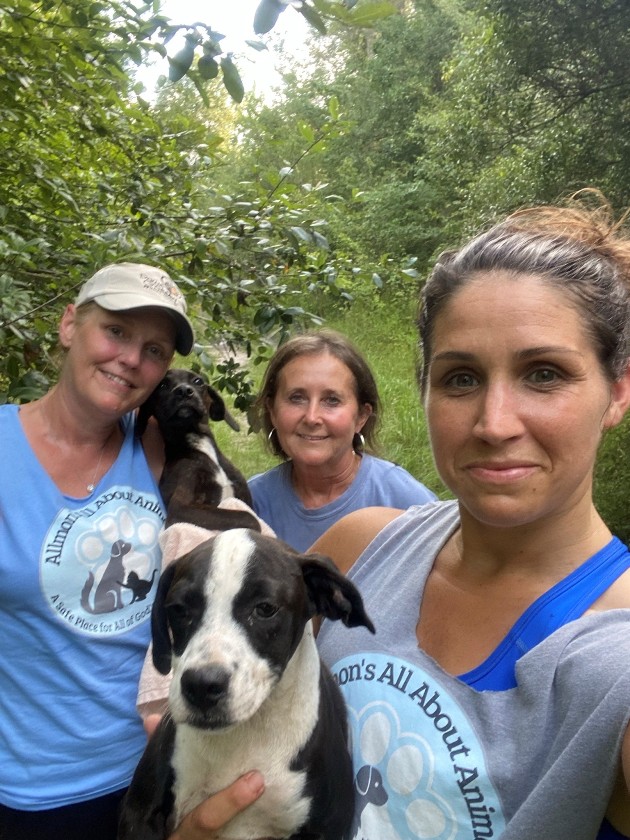
Rachel Monaghan (right) with a new bestest buddy. (photo courtesy of Rachel Monaghan)
In Rachel Monaghan’s case, she wanted to do something to overcome her grief after losing her own dog unexpectedly. She learned about Animal Aid USA through a friend, and has been hooked ever since her first trip.
“I was planning on going to three trips that year,” she remembers, “and I ended up going on I think six. I just became a regular caravan member.
“The best part for me is seeing the transformation. Obviously it’s awful what they go through, but seeing the resilience of them, and how they just still continue to love and trust people.”
Talbot says of the people giving their time to the caravan, “I’ve discovered that it’s not just them saving dogs. This movement has saved them. It’s saved their marriages, it’s stopped them from drinking, it’s made their life better at home. It’s their outlet to get away for a while to do something bigger than them.
“Nobody gets that until you come on a trip. Our motto at camp is ‘Our strangers leave as family’. And it happens to everybody. If you have a soul, it happens to you. It can’t not.”
In the face of a mentality that has existed for generations in this part of the world, Talbot and her team have taken on the most difficult of tasks: not just rescuing dogs…over 40,000 of them now…but also changing an established mindset that creates the need for their rescuing.
“You see it, in just the blank stares,” Talbot says. “People cannot believe that first of all, we would drive that far for a dog, and second of all, why?
“What we’ve learned is with our continuous journeys there, and the trust that we’ve built with these people. They know we’re not there to do anything except help. We want to change the next generation, we want to break this cycle, which we are.”
Talbot has seen that transformation in personal relationships, such as with a hardened animal control officer who now reaches out to Karen for help with dogs he finds.
“We laugh about it today,” she reflects. “When he first met me, he grunted at me, wouldn’t even make eye contact with me. I said look, I’m not here to point fingers, I’m here to help.
“A couple of years went by and he started to talk to me, he gave me his cell phone number. Then a couple of years later he was just like, ‘Hey, Karen, listen, I got so and so dog that just came in, you think y’all can take this one?’
“And this relationship blossomed. Plus some Tastykake cupcakes from up here helped too,” she adds with a chuckle.
Karen Talbot doesn’t spotlight her own role in rescuing dogs, even though it’s considerable. To her, it’s simply her life’s work. She always emphasizes the word “we” when speaking of the efforts of everyone involved.
“I had an idea, and I had a vision, but a vision is just a vision unless an army comes together to actually make that vision become a reality. We’re all volunteer, it’s just a life-long mission of ours.”
By providing the education, awareness and resources, she says, “We are empowering the next generation to make change in their world for companion animals. You’ve got rescue groups all over. But are you changing the mindset while you’re doing it?
“We are, and I think that’s what I’m most proud of.”
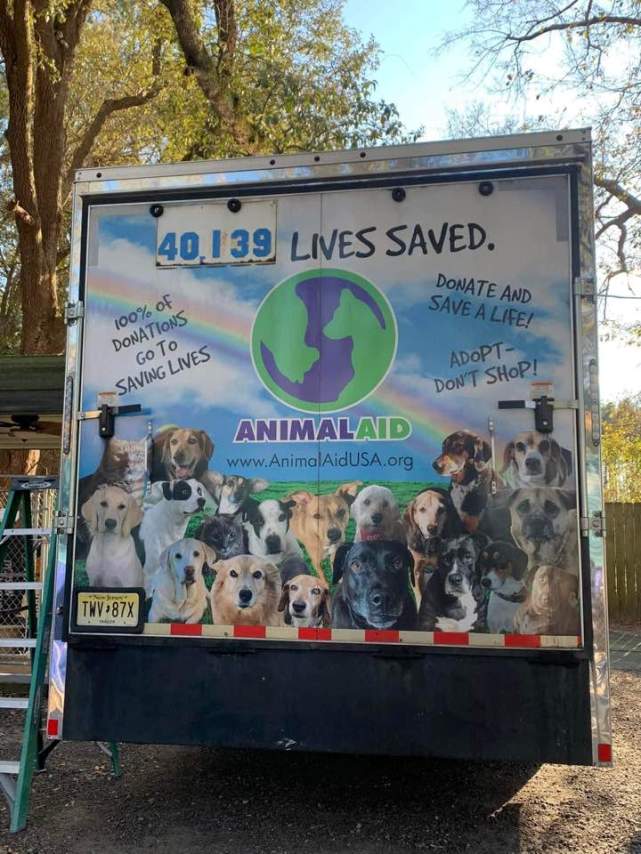
And counting. (photo courtesy of Karen Talbot)
An Animal Loving Bachelor
The rescue caravans at Animal Aid USA operated under different names in its early years, including MOMS (Making Of Miracle Stories) Rescue and Paws For A Cause, as Karen Talbot worked to raise awareness of dog rescues in rural Georgia.
Talbot fondly recalls the story of the huge contribution from Lorenzo Borghese, a name you may know…he was The Bachelor in the show’s ninth season. Borghese is an animal lover himself, and he wanted to help when he saw a documentary about the rescue operation.
As Talbot understood, his endorsement meant far more than a financial contribution he could have made.
“I was contacted by somebody who knew Lorenzo,” she remembers. “They wanted me to get introduced because (Talbot’s husband) Dante and I had started to take trips to Georgia. We went on our first trip in January of 2011, and on that trip, we had a borrowed van and we went down for 23 puppies.
“Once I met with Lorenzo, what I loved about him was there weren’t layers to get to him. He was the real deal, he reached out to me personally. I gave him a copy of the documentary which we had done.
“He knew that Dante and I were going back and forth to Georgia and funding everything on our own dollars and credit cards. Once he left our meeting he went home, watched this 25-minute documentary and was hooked.
“He said, ‘Are you looking for a check? Are you looking for money?’ I said, ‘No, I don’t want your money. I want something more important. I want a voice. People know who you are, they recognize you, they don’t know me.’”
Borghese suggested creating Animal Aid as an umbrella for MOMS Rescue, which he then lent his endorsement to. The “USA” was added when they learned that another “Animal Aid” already existed.
“That’s when Animal Aid was born, and so we incorporated Animal Aid is a non-profit. All the while, I still kept Making Of Miracle Stories, and Animal Aid just took off.”
Borghese adding his voice undoubtedly helped the effort. Talbot made a wise choice asking for it over a check…which she says would have been spent in a week and immediately forgotten.
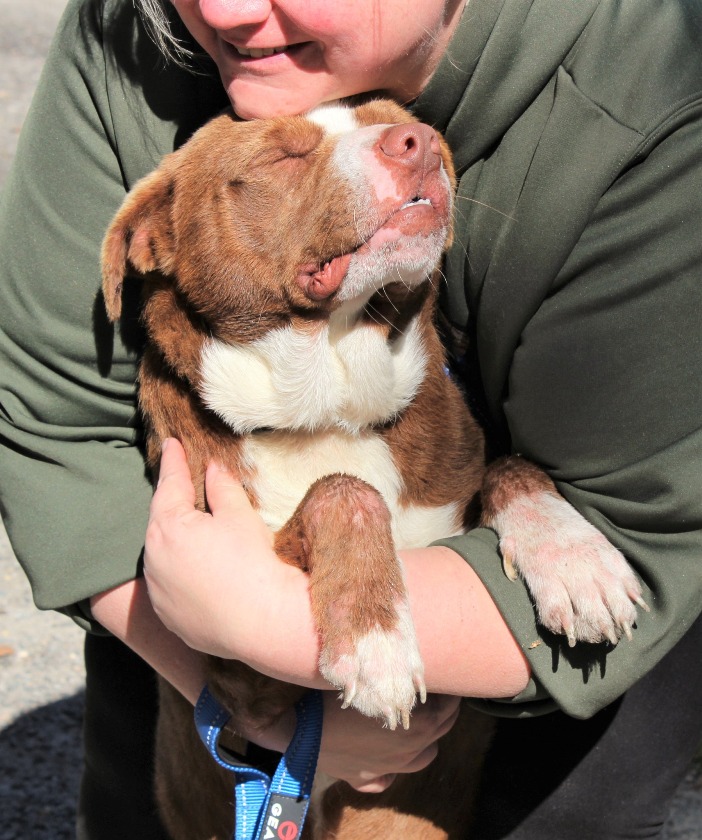
Being adorable in their natural state. (photo courtesy of Karen Talbot)
The Video
On the Animal Aid USA website, you can watch a video of their being featured on “To The Rescue” docuseries, with host Tommy Habeeb narrating the full experience of the caravan going back and forth from Williamstown.
The video shows the Georgia compound where dogs are held until the caravan arrives, as well as the medical facility where vets handle spays, neuters, and heartworm treatments. Habeeb hears about the entire process from Talbot, who describes the logistics from dog food deliveries to the 38-foot transport rig that holds 64 crates.
Throughout the video, you see Georgia dogs in their natural state of being adorable, making the work that Talbot describes as grueling seem not only worth the effort, but not difficult at all. But Talbot shares that people are exhausted by the end of the project, wondering what they’ve signed on for, until the sun comes up during the ride home and they see the light at the end of the tunnel.
The caravans could easily be a reality show, you might think while watching. But Talbot is quick to shoot down pitching the idea of a reality show to a network, as this writer suggested.
“It’s a real reality show every 28 days down there,” she says. “But for me, living it on a daily basis and being in Georgia…Rachel’s amazing, it’s not a bad idea for her to set up a YouTube channel with a following, where we are real and raw.
“You’re not getting raw in reality TV. And you’re also controlled, and it’s scripted, and I am the furthest from being controlled or scripted.
“They don’t like that at all!” she says with a laugh.
The video is well worth a watch…go here to see it.
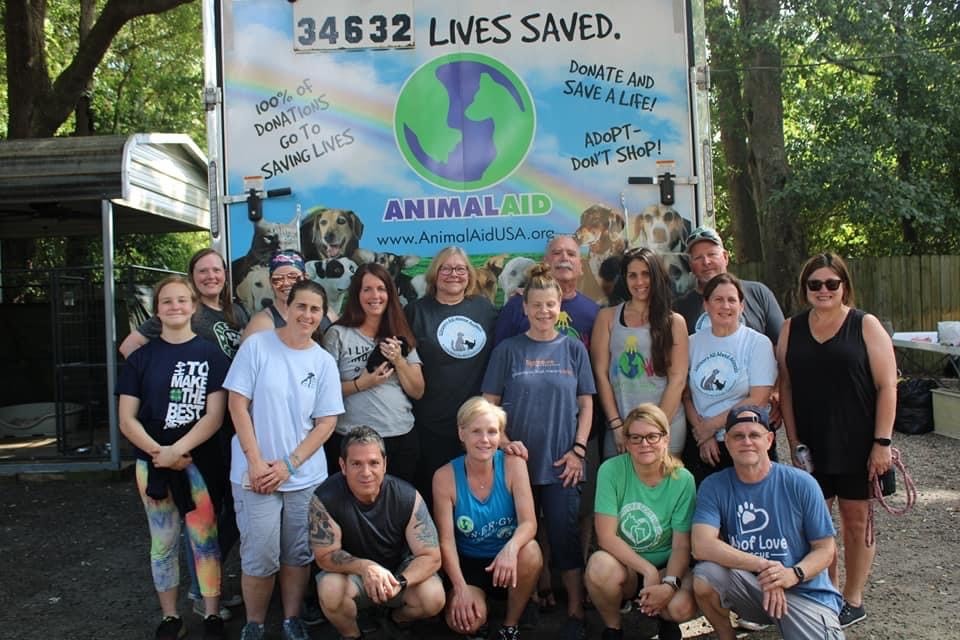
You are welcome to come join them. It’s life transforming. (photo courtesy of Rachel Monaghan)
Put It On Your Bucket List
Karen Talbot and Rachel Monaghan were happy to invite this observer to join them for a caravan trip. It’s something to consider, even if you just like long overnight road trips and need a worthwhile reason.
As Talbot says, the caravan has even saved marriages, and she cites her own as an example. Her husband Dante, who now drives and maintains the big rig of the caravan, had at one point tired of her devotion to the cause and requested a divorce.
“I immediately chose the dogs,” Talbot says.
“The following summer after the giant Georgia puppy caravan, we then had our documentary premiere in Philadelphia, and all the people that came on the caravan…the pilot, the rescue groups, everybody, was in attendance at the Trocadero.
“Dante was there because we were still friends, and he saw what I was doing from our bedroom on a computer, and he vowed to make it up to me the rest of my life if we got back together.”
The power of puppy faces. “It’s really funny because the reason we divorced was dogs, and once we re-married and got back together again, he’s worse than I am with dogs.”
Hopefully your marriage isn’t in need of helping dogs to save it, but if you’re interested in lending a hand and the life transformation that all of the volunteers speak about, you can reach out on the Animal Aid USA website and see if they need help with the caravans, which they usually do.
“Put it on a bucket list at least once in your life,” says Talbot.
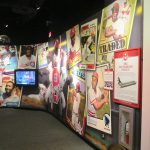
The First Professional Baseball Team
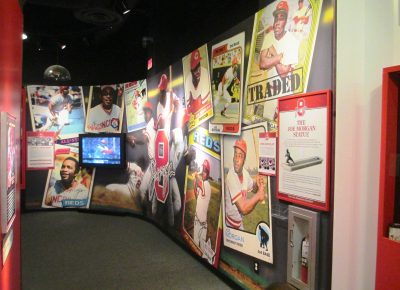
I’ve always known that Cincinnati was the home of the first professional baseball team, but until I visited the Reds Hall of Fame and Museum, it always puzzled me how the Red Stockings could be the first baseball team…because how could there be just one team? Wouldn’t they need someone to play against? Did they just stand on the field practicing until another team filled out all of the legal forms? Maybe they signed the contract for their ballpark the day before the Phillies did or something?
I wouldn’t say it kept me up at night, I knew there had to be an explanation, but it was just one of those things that puzzled me a bit.
But now I get it…one less thing to waste brain power pondering.
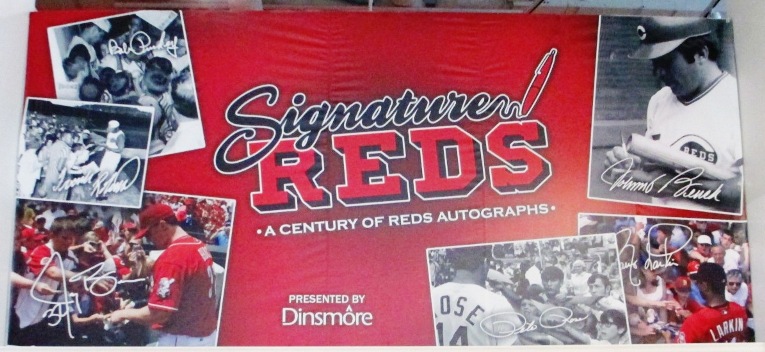
Even from way back in the days when they had no one to play against!
The Reds Hall tells the story—that the Red Stockings were the first professional baseball team because they were the first team whose players were actually paid to play baseball. Other teams’ owners balked at the idea of ballplayers being professionals (some things never change), but the Red Stockings were willing to pay players. And by doing so, they attracted some of the best talent around. No doubt radio show hosts in other cities began demanding that their team owners start paying players.
This all-star team of professionals went on a tour in 1869 and won everywhere they went, finishing their first ever season unbeaten and actually drawing some crowds on the road. (I think hot dogs were $1.50 back then.) This was back in the days before gloves and catcher’s masks and the DH, proving that people will play baseball for money even if they’re risking life and limb.
Their second season was marked by dissolution and player bickering (that didn’t take long), despite that the team resumed its greatness, winning all but one game against the Brooklyn Atlantics, in an 11-inning affair. Eventually some players moved to Boston, as did the Red Stockings name—now the Red Sox, of course.
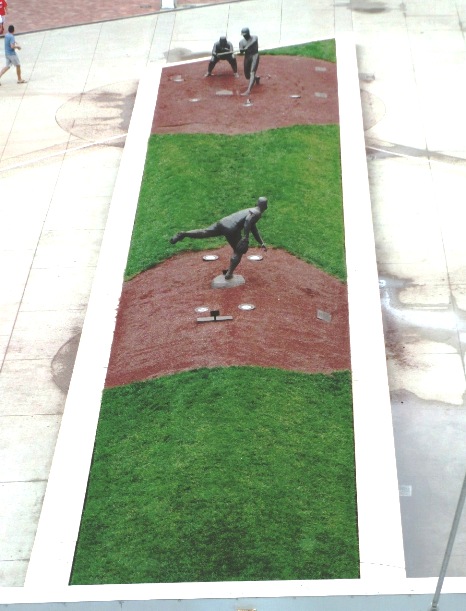
Did they even wear gloves back then?
The team disbanded, and then a new Red Stockings team joined the newly formed National League in 1876. This team was banned from the National League for…get this…serving beer at ballgames. Nowadays a team might be banned from the league for not serving beer.
Finally in 1881 another Red Stockings team (they loved that name for some reason) joined the rival American Association, and in 1889 they moved to the National League, replacing the bootlegging Red Stockings team that had been booted. In the move, they changed their name to the Reds, probably to save on stitching costs.
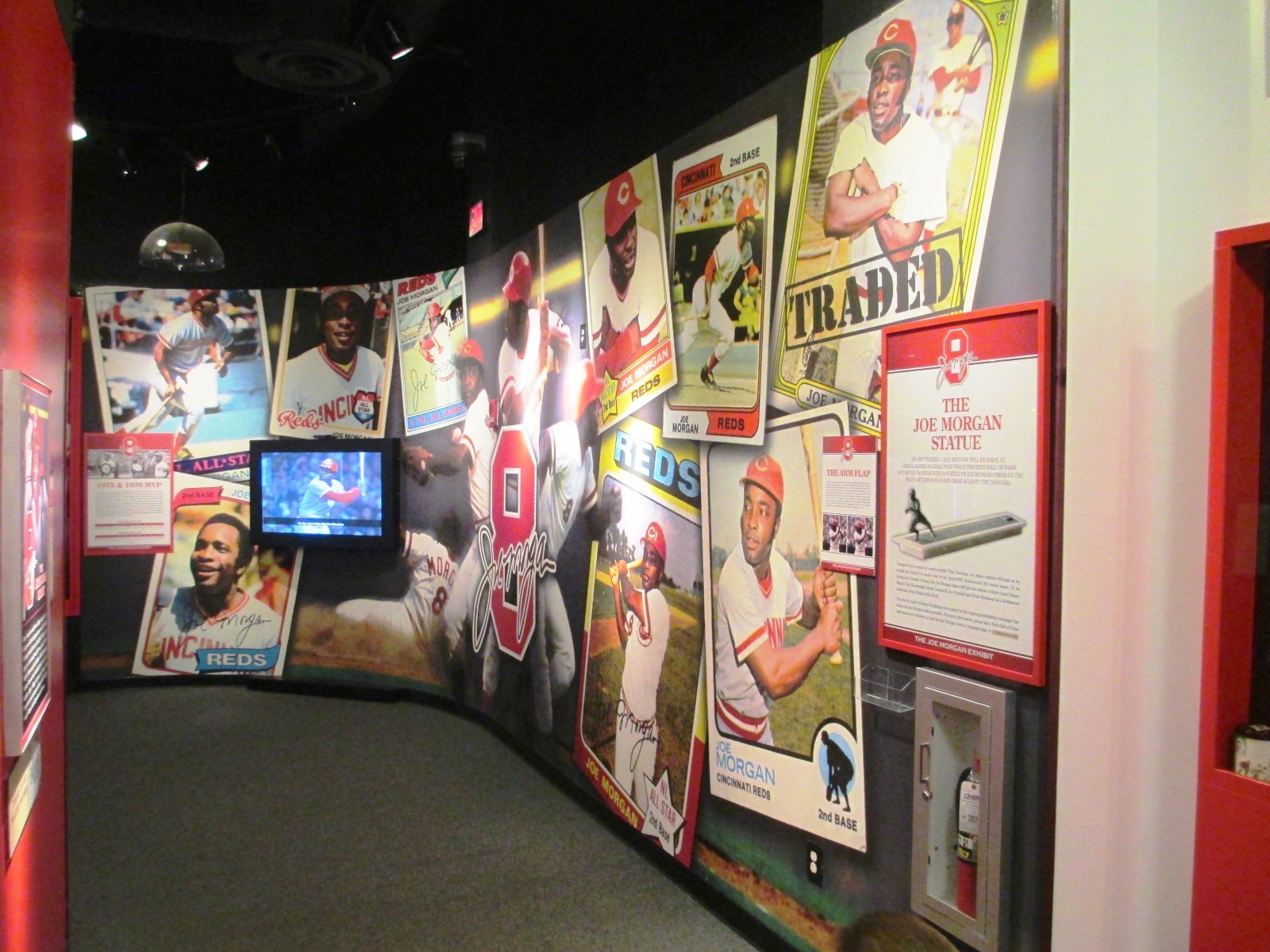
The city would go on to host quite a few pretty good teams.
So the current incarnation of the Cincinnati Reds that we all know today wasn’t exactly the first professional baseball team, but you could argue that Cincinnati simply hit a few bumps in the road to become America’s first iconic baseball town.
There is a great deal of history when it comes to Cincinnati baseball, and it’s as good a place as any for a team to feature a Hall of Fame and Museum that is a microcosm of baseball’s Hall in Cooperstown.
The Reds Hall of Fame is definitely worth the visit if you’re coming to Great American Ball Park, if only to learn how there could only be one “first professional baseball team”.
But of course, there’s a lot more to know about Great American. Especially if you’re visiting for the first time.
(Note: this article contains affiliate links. If you use an affiliate link to make a purchase, A Great Number of Things earns a commission, at no extra cost to you. Thanks for your support!)
Hope you enjoyed this article about the first professional baseball team and how it came to be…
If you did, I would really appreciate your support.
When you use this link to shop on Amazon, you’ll help subsidize this great website…at no extra charge to you.
Thanks very much…come back soon!
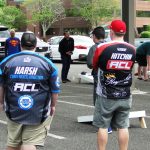
Professional Cornhole – Beyond The Parking Lot
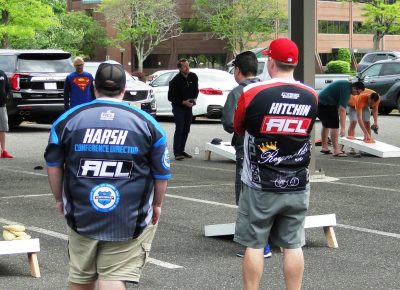
JerseyMan asked me to cover a local cornhole event they arranged, and to work in a piece about the phenomenal growth of professional cornhole in the midst of the COVID-19 pandemic. Hope you enjoy it. You can also view the PDF of the article here.
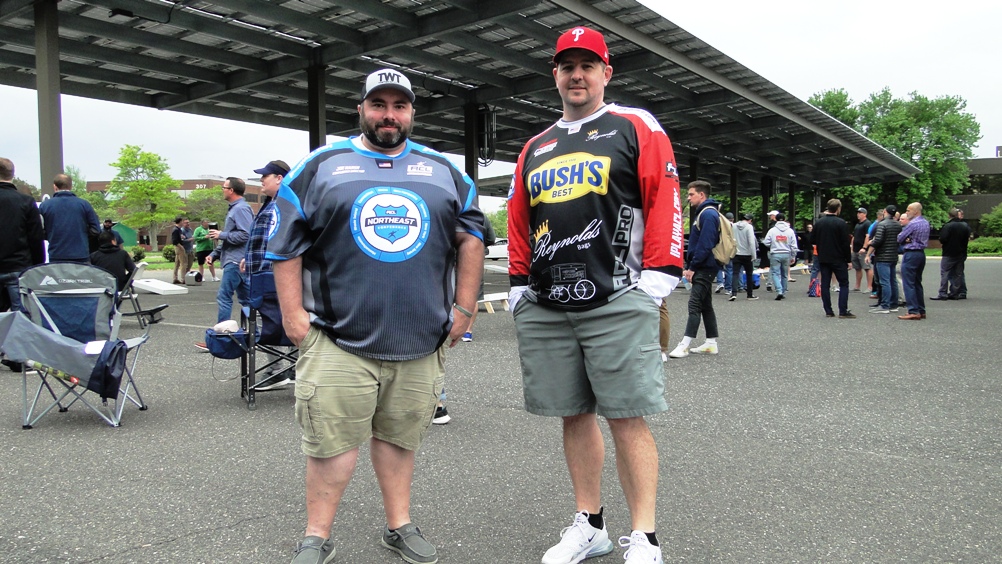
Professional Cornhole guys.
Beyond The Parking Lot – Professional Cornhole
You can write for JerseyMan and attend Legacy Club events for ten years, and almost never see Ken Dunek animated enough to shout loudly and pump his fist.
Then again, you don’t see many people gain a lead against John Kitchin in a cornhole match, however short-lived that lead may be until Kitchin finds his bearings and starts effortlessly nailing throws. It’s understandable for even a reserved person to be thrilled at the achievement.
This anomaly was at the Infinity Club Cornhole Tournament, held this May at the PCS facility in Moorestown. The event raised nearly $4,000 for the Leukemia & Lymphoma Society, and for survivor T.J. Smink’s bid for the Society’s Man or Woman of The Year.
Of course, many esteemed Legacy Club members were present. It’s an ideal opportunity to avenge a recent defeat on the golf course. No one tanks, of course, but a loss isn’t so bad…it’s an opportunity to grab a drink and catch up with fellow members.
One would think that, in a crowd of Eagles fans, who have to have considerable tailgating experience, there would be some players standing out in the crowd. But other than Smink’s team, who prevailed in the match, most of them were unexceptional shooters. Even by frequent tailgater standards.
The tournament was for fun and to help less fortunate people. PCS’s parking lot is obviously no billion dollar, luxury box-filled venue.
But professional cornhole has grown well beyond the parking lot.
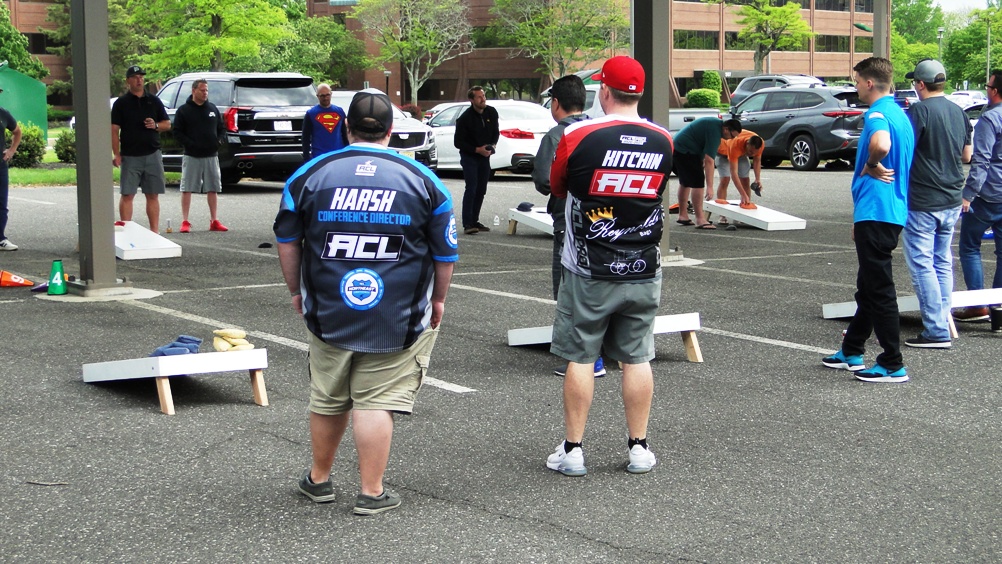
Apparently, everyone else forgot their uniforms.
Present at the gathering were Kitchin, a national cornhole pro who resides in West Deptford, and Joe Harsh, the American Cornhole League’s (ACL) Northeast Conference Director.
Yes, there is a nationwide professional cornhole league. As seen on TV.
Before 2020, the ACL had already landed some national television deals, and events could be seen on various sports networks. Then they got a boost…professional cornhole became one of the rare entities that benefited from an outbreak. With no baseball, football, basketball, hockey, etc., there was a fairly ginormous hole in sports broadcasting to fill.
So cornhole moved into seriously choice TV slots. Harsh notes that “We had eight to ten broadcasts on Saturdays, prime time with our Pro Division, and traveled all over the country.
“We’re really fortunate,” he adds. “Everything went well for us. And the exposure and the growth, it’s been really, really beneficial to the league.
“I’ve known John for a couple years now, and the fact that someone would ask John for an autograph, it’s the coolest thing.”
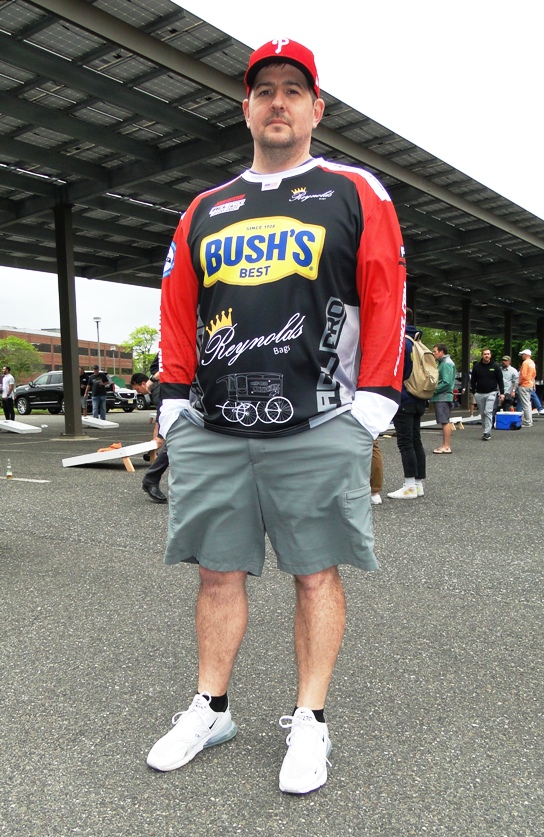
John Kitchin, who is probably better at cornhole than you.
Kitchin has been known to drive to Cincinnati for the day to throw bags. At least, that became a thing for him when someone noticed he was a pretty good shot at tailgates.
“I played in the parking lot of Eagles and Phillies games, and a guy came to me and said, ‘Hey, we have a league for this.’ I kind of laughed at him. Here I am seven years later, and if I could play more I would.”
Indeed, Kitchin started playing in a league, and did well enough to compete in local tournaments. Then he became a pro. Then an ACL Pro.
He’s added some impressive achievements to his league bio…#1 Northeast Conference player in 2018, ACL Man of The Year in 2019, and a 2nd place finish in the 2020 USA Cornhole Club Championships – broadcast on NBC Sports – to name just a few. He’s so good that Bush’s Baked Beans and LG have put their logos on his jersey.
You can see why even Ken Dunek would celebrate well beyond his typical demeanor scoring a lead against him. Which, to Kitchin and Harsh, is part of the appeal…anyone can play, even against the pros.
“I play in leagues around here all the time,” Kitchin says. “I play pretty well, but there’s a lot of people who, when they play against me, they use that as a measuring stick. I don’t beat everybody, so I think that makes them even more interested…‘That guy’s been on TV!’”
“That’s the coolest part,” Harsh adds. “You can see him on TV on the weekend, and then Monday or Tuesday night you could literally play against him.”
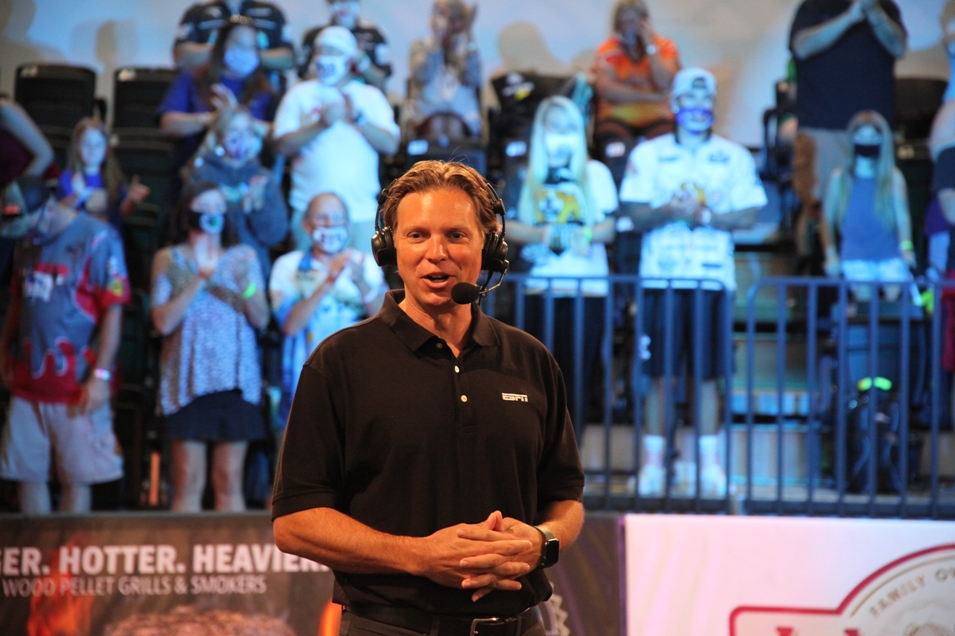
Professional Cornhole announcer Jeff McCarragher, offering his well thought out insight about a match.
(photo courtesy of Jeff McCarragher)
Jeff McCarragher is a freelance sports broadcaster. His LinkedIn profile describes his most recent position as a “Play-by-Play Announcer for College Football & Basketball…and yes, Cornhole too.” His resume covering other sports is impressive, but by most any measure, McCarragher is the Voice of American Cornhole.
He landed the gig by simply being in the right place at the right time. Literally.
A South Carolina resident, he worked college football and basketball throughout the Carolinas. Tupelo Raycom, the company that brought him announcing work, had an office there. And they knew ESPN needed a cornhole announcer.
“When COVID hit, being a freelance play-by-play broadcaster was like being a waiter or server at a restaurant,” he remembers. “We were shut down immediately because all the sports just went away. When they got the contract on ESPN, they called me and said, ‘Hey, are you willing to travel if we put together cornhole through the summer?’
“I had done a little bit for them in the past, I’d done the national college cornhole championships that previous New Year’s. I said, absolutely, I’m comfortable traveling. And so away we went, ESPN signed a deal with the American Cornhole League.”
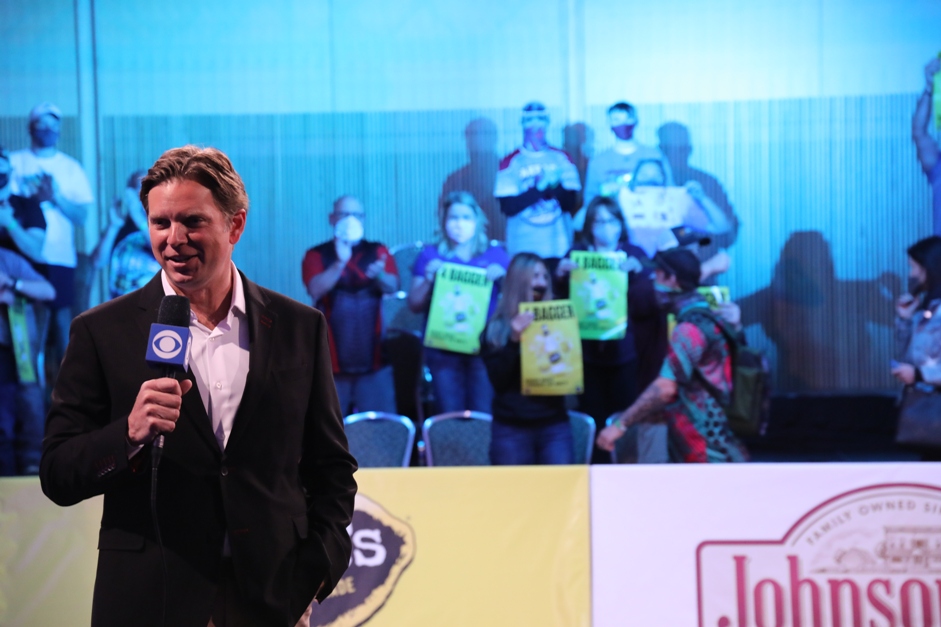
No, those aren’t protestors. They’re cornhole fans.
(photo courtesy of Jeff McCarragher)
McCarragher’s enthusiasm for covering professional cornhole of all things is palpable. The players may not have toiled through college or minor leagues, but they definitely have well-developed skills.
“It’s a very simple sport, right? You just slide it up the board and put it in the hole. But just like any other sport, when you get to a very high level, you start to learn how technical it is. I had to learn a whole new vernacular, whether it’s replacement bags or grab bags, the way a player collects the bag.
“I relate it to being a really good major league pitcher. He’s got his fastball, his slider, his cutter, his change-up. The ones who play at the top level, they’ve got a little cut shot, they’ve got an airmail shot. They can make the bag curve one way or another, they can angle it and get the bag to kind of roll. Instead of different pitches, they have different technical shots that they can throw. It’s really pretty amazing.”
There’s considerable tension in big matches, too.
“It gets to be like golf,” he continues. “You’ve got a two-stroke lead, or maybe a one stroke lead, going into the 72nd hole on Sunday. I don’t care who you are. That final tee shot on the 18th? It has to be good. There’s so much pressure. Again, I get it, it’s cornhole. We’re not talking about the Masters. But it’s still competitive, the desire to win for these players.”
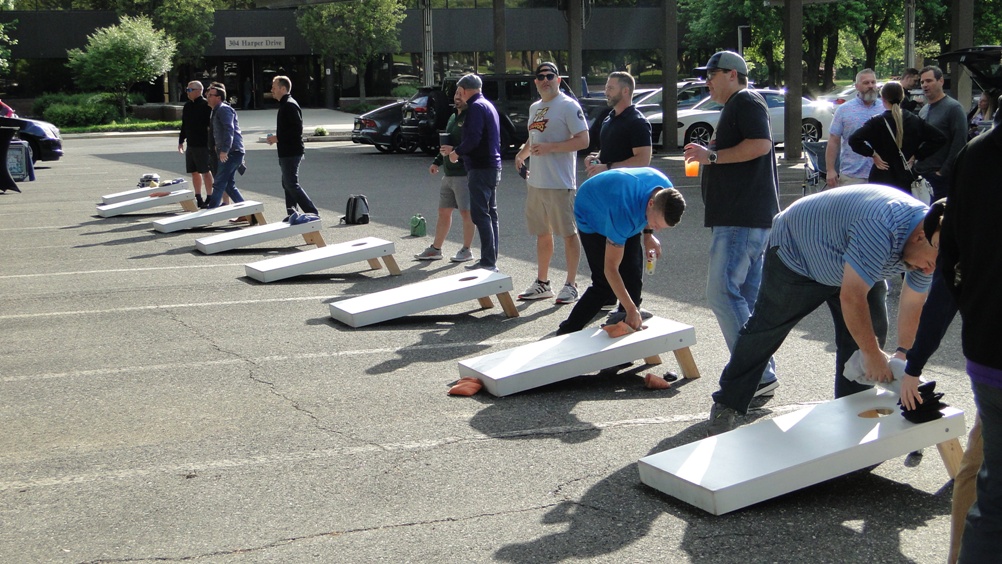
Aspiring cornhole pros at the Legacy Club event.
McCarragher is confident that the growth of professional cornhole will continue, even with the return of other spectator sports.
“Did COVID help give it added exposure? Absolutely. But I will tell you, they have been working behind the scenes with these little ESPN contracts now for several years. They were on ESPN a few times in 2018-2019. We had college national championships on New Year’s Eve going into 2020. The ratings were slowly going up and up. So this was already on the rise.
“Just by the sheer TV contracts that are coming in and new sponsors, I for sure would say that the ACL is still growing.”
Kitchin agrees.
“I think the success they had during COVID is going to allow them to continue. Will the viewership be the same? Perhaps not, but I think in this country there’s a niche for these types. Like, would you watch baseball, which is hours long, or you’re clicking through and, ‘Oh, cornhole, this is something I do in my backyard. My buddies and me bust our chops all the time, let me watch this. I think that’s what’s opened it up for those types of things.”
Joe Harsh has already experienced professional cornhole’s impact beyond TV.
“For me it’s not even the size of the events and the cool venues we’ve visited. It’s some of the charity work we’ve done, like for veterans groups. We did an interview with a guy, roadside bomb in Afghanistan. Long story short, he’s a double amputee, and he’s thanking me for everything I do, and it just absolutely blows my mind.
“I would do anything for someone like that because they’ve given so much, and they’re thanking us for what we do and the release that we give them. That’s my favorite thing to take away from all of this.”
Needless to say, McCarragher is eager to keep telling the story.
“I would love that guys would call and have me do a national college football championship. As young broadcasters coming up, we all hope to get that call. But even that being said, I still really would always hope I can continue doing cornhole.
“I will do this for as long as they’ll let me, because I love it.”
Hope you enjoyed this article about Professional Cornhole…
If you did, I would really appreciate your support.
When you use this link to shop on Amazon, you’ll help subsidize this great website…at no extra charge to you.
Thanks very much…come back soon!
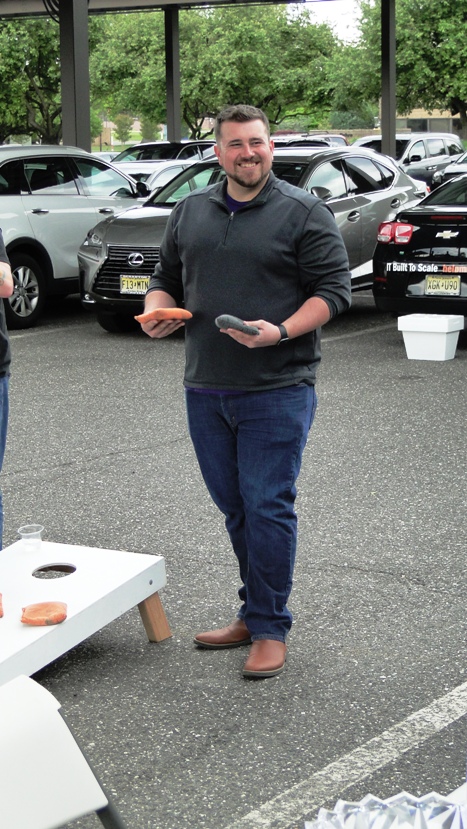
T.J. Smink, defeater of cancer and local cornhole legend.
Smink Strong
T.J. Smink, who won the Infinity Club Cornhole Event with his partner Kyle Reider, had personal reasons for both winning and co-arranging of the event: he is a cancer survivor himself.
Smink is a Senior Account Executive for Premium Seating with the Philadelphia Union. But in 2020, the shutdown of sports was the least of his worries. In December of 2019, he was diagnosed with stage four Hodgkin’s lymphoma.
He decided to control two things that he could control: his hair and his attitude. He shaved off the hair he felt he was going to lose from treatments…but ultimately didn’t. And he kept upbeat, all the time.
“I made sure to keep a positive attitude, to look on the bright side of life. Having that mindset, being able to say I’m going to beat this s***, that was way more than half the battle.”
Legacy Club member Devin DiNofa, at the time campaigning to be the Leukemia & Lymphoma Society’s Man or Woman of The Year, reached out to Smink.
“He’s an awesome dude,” Smink says. “He asked if I would be on his team to help raise money for others. Even then, he wanted to work with LLS to raise funds for me directly, LLS said we can’t go towards one specific person.
“Even then, I went back and told him, I’m killing this s***. We’re good, I appreciate it, but I would prefer it goes to someone who actually needs the funding.”
Today Smink, at DiNofa’s urging, is campaigning for the LLS Man or Woman of The Year himself. The Infinity Club Cornhole event was a part of that, to great success.
“Ash (Ashley Dunek) came up with the idea of working one of the Infinity Club events into a fundraiser. And we had a really big turnout. There were 32 teams and a lot of people that came just to hang out.
“Our team is going to get a research portfolio named after us. I’m excited to see where that research goes.”
And he and Kyle Reider topped it all with a cornhole tournament win.
“He’s a lot better than I am,” Smink says of his teammate, “but together, we normally win all of our friends’ get togethers and stuff.”
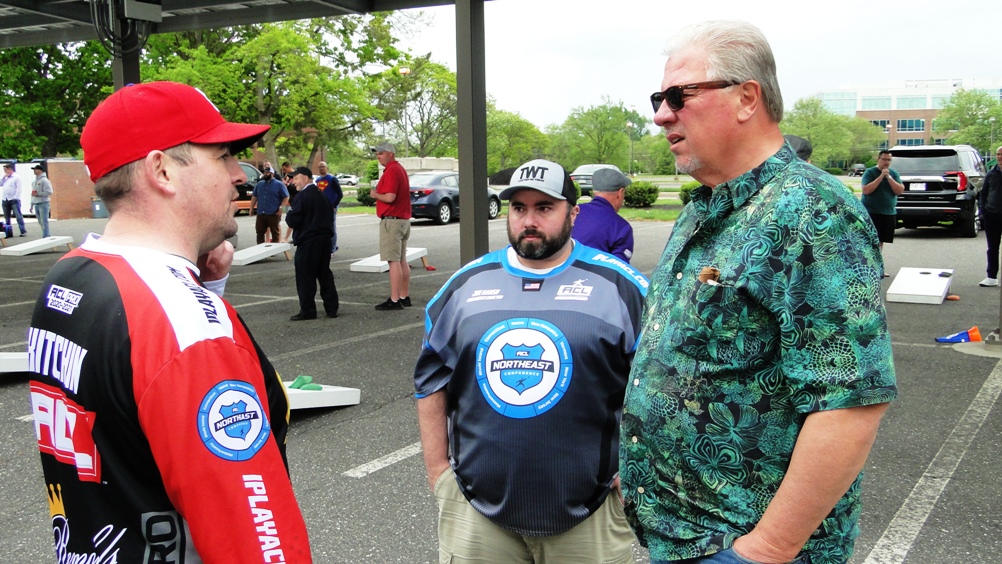
Ken Dunek, feeling relieved at the end of his match with John Kitchin, asks Kitchin for cornhole tips.
So You Want To Be A Professional Cornhole Player?
In a write-up about John Kitchin from Power Equipment Direct’s website, he is described as a professional cornhole player who “practices for roughly 32 hours per week, where he throws 2,000 to 3,000 bags.”
While that is probably technically true, Kitchin doesn’t exactly work in his garage, perfecting his follow through and stance and watching himself on video. He just plays a lot, which to him is the simple secret to improvement.
“When you figure in going to leagues and playing tournaments on the weekends, and then throwing it in my shop or something like that, the amount probably adds up. I play on the leagues on Tuesday nights and Wednesday nights, and Thursday nights usually where I try to get out too.
“If you want to become a better cornhole player,” Kitchin continues, “just get out and play, go find a local league. Even if it doubles as a night out, you know, go out and play. You’ve just got to get throws in, and if you can’t and you just throw in the backyard, go out and throw. You have to throw bags.
“So practice for a pro to me would be going out and playing in your own league and it’s all about getting throws in.”
Wait, no proper ways of holding the bag? No commentary on wrist movement? Nothing about how to warm up? Kitchin says that once you find a groove that works for you, the mental aspect is far more important. And that part can’t always be taught.
“I’m probably the worst pro to talk about this, because I’m a firm believer of under-thinking. People overthink. It’s whatever is most comfortable to you, you just have to tweak that. Throw eight bags, and I would want to see how you threw. And I would say, was that comfortable? If that’s comfortable for you, you can tweak it from there.”
That sounds simplistic, but he’s right. Cornhole players lose matches overthinking.
“I might throw 50 bags in a row in the hole, but what changes from the time that you just threw 50 bags in a row and then you line up next to me? What just changed? Nothing changed except for your mental, so you’re overthinking it. Now all of a sudden that same guy who’s just hit 50 bags in a row off to the side warming up, is now maybe two on two in. It’s the overthinking.”
“I try not to worry about all that.”
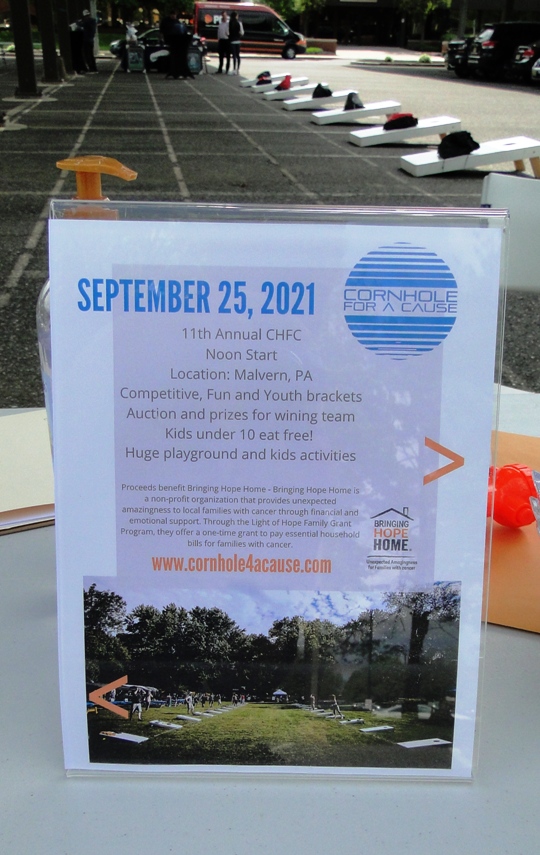
Cornhole for a cause.
Why We Cheer – The Human Interest Stories
The ACL is fortunate to have Jeff McCarragher behind the microphone, because he does what the best broadcasters do…he tells backstories about the participants.
He shared a small few everyman stories of cornhole stars with JerseyMan.
“Steven Bernacet, he won the singles national that we just had in Wichita about a month ago. Outstanding cornhole pro, but in his senior year, he was a great high school football player, lineman. He was in a horrific car accident and broke his neck. He could have died.
“The doctors immediately told him he wouldn’t play contact sports ever again, obviously to a high school kid who’s played sports his whole life, it’s devastating to him and his family. Two years later, once he was able to rehab and get back to his new normal of life, he picked up cornhole, and has been playing cornhole ever since now.
“It’s been his outlet and his happiness and his source of competitiveness, to fill that desire and that need in his life. Cornhole has been literally life changing for him.
“One of the top female pros is a manager at a Taco Bell. You know, she plays cornhole on the side. Daymon Dennis, who’s the number one player in the world right now, worked at a cheese plant for 27 years.
“He used it to support his family and to keep food on the table. And now here he is, number one player in the world.”
“It’s like American Idol,” McCarragher says. “There’s a lot of people who can sing, but what captured the audience and the ratings for American Idol is all the backstories.”

Is PNC Park The Best Ballpark in Baseball?
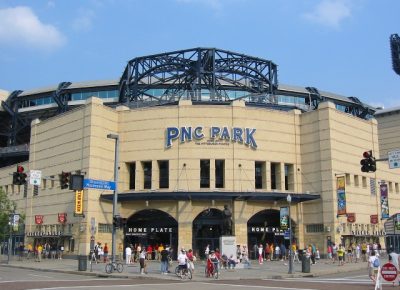
Asking the question “Is PNC Park in Pittsburgh the best ballpark in baseball?” doesn’t offend too many people. At the stunningly beautiful home of the Pirates, you will often see signs around the ballpark proclaiming it to be “The Best Ballpark in America”. As far as I know, there’s no outrage about this from fans of other ballparks.
What if the Cubs put such signs around the outside of Wrigley Field? Might Red Sox fans sneer a little bit? And vice versa, if signs appeared around Fenway Park proclaiming it to be the best ballpark in the country, would that not get a reaction from Cubs fans? Just a thought.
As someone who has visited a few ballparks but not all of them, I can say that while the question of whether PNC Park is the “best ballpark in baseball” may be debatable, one wouldn’t have too much trouble making the case.
So What Makes PNC Park The Best Ballpark?
There’s a lot of obvious things to love about PNC. The view, for one.

It’s the bridge. The bridge makes it.
From almost any section in the ballpark there is the stunning vista of the downtown Point area of Pittsburgh, linked to the ballpark itself by the Roberto Clemente Bridge painted in Pirates/Steelers/Penguins gold, crossing the Allegheny River.
And the approach to the ballpark from downtown is as classic baseball as it gets—a walk across the Clemente Bridge past vendors hawking snacks and apparel, with the open air and dark blue seats in full view while crossing the Allegheny River by foot. Few ballparks if any could match that.
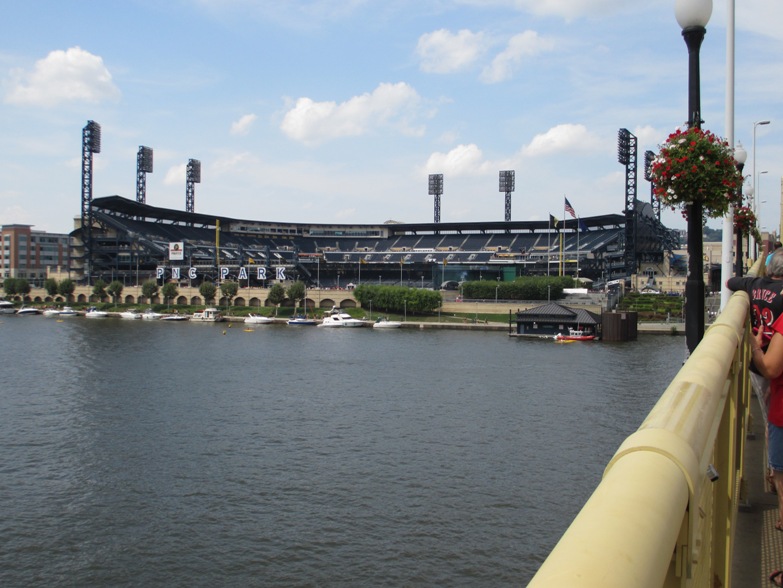
I would pay for this view, but don’t tell the city that.
Then there’s the ballpark itself—Kasota limestone on the outside; the statues of Bucs greats Clemente, Stargell, Wagner and Maz; the rotunda in left field with views of the ballpark and the city; and the intimacy of just 38,000 seats, painted dark blue in homage to Forbes Field.
And there are some not so obvious things too. There’s the matter of the price of tickets, which may not be a fair attribute to discuss given that the Bucs didn’t secure a winning season there until 2013.
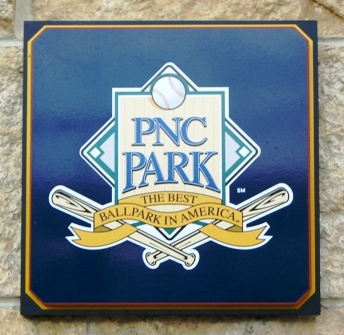
Not even a discussion? Wrigley? AT&T?
But poor performance on the field didn’t stop the Cubs from charging a chunk of change to get into the ballpark for many years. From the most to least expensive seats, Pirates games are competitive in price with any team in baseball.
The architects of PNC Park did a tremendous job building intimacy into the place. The ballpark was not only built with a small amount of seats, it was done without raising the upper level to nosebleed height as it is in many new ballparks. The Pirates brag that the highest seat is only 88 feet from the field, and there’s no question that you’re still on top of the action even in the upper deck. This is something that no ballpark built since has achieved, at least none of the ones that I have visited.
Don’t pay PNC Park prices for Pirates gear and souvenirs!
Order your essential Pirates items before you go at Amazon.com, pay far less than you would at the ballpark, AND get free shipping on orders over $25…click here!
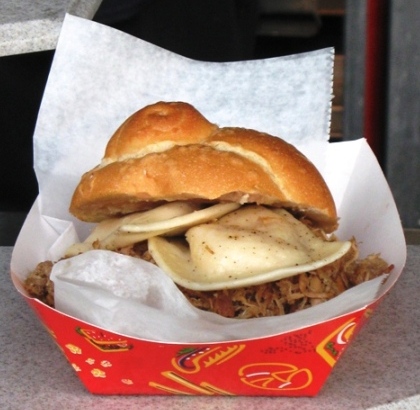
Anyone want my extra pierogi?
There’s food selections of all kinds, from the venerable Pittsburgh favorite Primanti Bros. to Chickie’s and Pete’s fries to the BRGR burger joint. You may not necessarily love the idea of a pulled pork sandwich with pierogies on it, but you can’t deny the Pittsburgh-ness of that. And there’s Iron City beer…nothing makes a ballpark like a bad local beer.
I’ve been to ballparks with better food and better access. But PNC is pretty easy to get to by car, and you have the option of using a bus, train or even a boat. Heck, you could ride a bicycle there along the Riverwalk and that would be pretty cool.
But to this observer that isn’t all that important. It’s not easy to get to Wrigley Field, but I don’t care once I see the ivy and ancient scoreboard. And when in Fenway Park, a Fenway Frank tastes as good as any gourmet meal anywhere else.
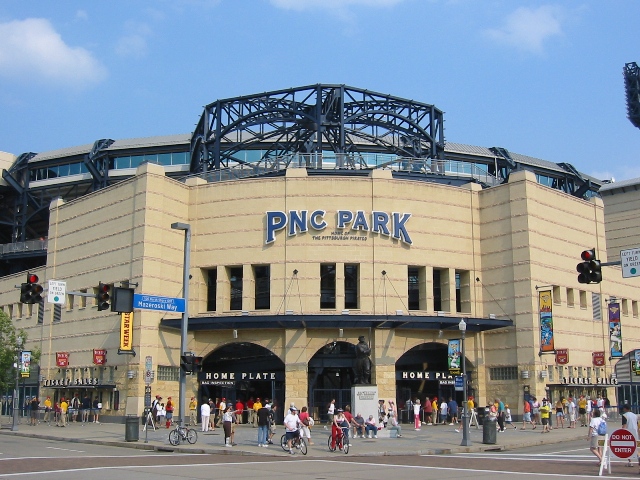
Get ready for whatever your favorite was to be #2.
I have yet to see AT&T Park, Safeco Field, Target Field or Coors Field, all of which have been touted as the best in America. Of the ballparks I have visited, I’m partial to Camden Yards, Wrigley Field, Fenway Park—and without doubt, PNC Park in Pittsburgh. On almost every level, PNC is as good as or better than all of them.
So if you ask the writer of Ballpark E-Guides whether PNC Park is the Best Ballpark in Baseball, my answer is: if you think so, I won’t argue with you.

Great Gifts For Red Sox Fans + Fenway Visitors
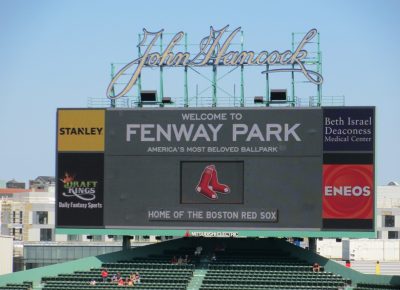
So you’ve got a Red Sox fan in your life, and you’re thinking about something that would make a super gift? As a ballpark guy, let me give you my best advice in gifts for Red Sox fans: give them something for their next game at Fenway.
Tickets obviously make a great gift, so here’s an excellent primer on how to find deals on Red Sox tickets for your loved one. But the Sox fan needs other equipment when visiting their favorite place on earth.
Stop paying ballpark prices for your Red Sox gear and souvenirs!
Order your essential Sox items before you go at Amazon.com, pay far less than you would at the game, AND get free shipping on orders over $25…order your Red Sox swag today!
Full disclosure: Ballpark E-Guides is an Amazon affiliate, so if you use these links to make a purchase, this website earns a commission at no extra cost to you. So you’re not just buying a super gift for a Red Sox fan, you’re helping baseball fans everywhere!
So thanks. Now then, Red Sox fans know about sitting in a chilly ballpark…
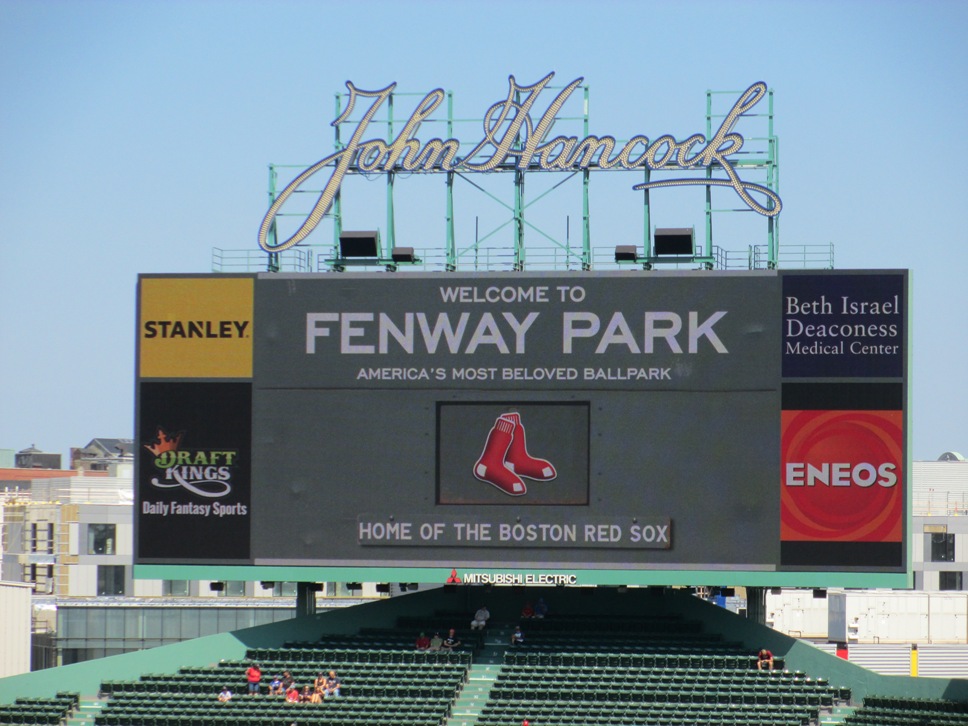
You did remember your leg warmers, right?
Gifts For Red Sox Fans, Part 1: Staying Warm at Fenway
Bundle up kids…Fenway Park can be a very cold place, especially in April…and October! So be sure that you look into some of these accessories as possible gifts:
This one is really really cool: sneaker slippers! I mentioned these in my gifts for Cubs fans post, but they’re made for Red Sox fans too: check these out here.
These footie slippers would look great on a lady Sox fan, and they’ll keep her feet comfortable and toasty on a cold game day.
There’s nothing like a knit cap to show your allegiance on a chilly evening at Fenway, and this particular edition is not only the nicest looking but also comes at the best price.
Amazon has a nice selection of hoodies and sweatshirts here…
(This one is my favorite, in case you’re thinking of getting one for me.)
And this sweater would be nice for the lady Sox fan in your life.
Scarves are underrated as necessary April/October baseball fan apparel at Fenway, and I think this decorated scarf makes a fantastic looking gift.
And a nice pair of gloves would go great with the scarf. (Are you starting to enjoy the image of your favorite Sox fan decked out like this?) This pair is Amazon’s choice and the price is great.
Finally, if you can manage to bring this fleece blanket into the ballpark on an April evening, you’ll be very glad.

Save the Red Sox fan in your life a trip to this more expensive spot.
Gifts For Red Sox Fans, Part 2: Essential Game Day Apparel
You’ll need a cap at a Red Sox game of course, and they’re much cheaper on Amazon than they’ll be at the ballpark (and that may even include the outside vendors). Here is their selection, including a cool green St. Patty’s Day cap.
As far as caps go, I prefer the red cap to the dark blue one, and this is likely a better deal than you’ll find inside the ballpark.
As I’ve stated on the Cubs fan gift post, there’s a much better selection of jerseys in the MLBShop.com store (maybe I should become an affiliate), but if you can find something on Amazon, it will probably be cheaper.
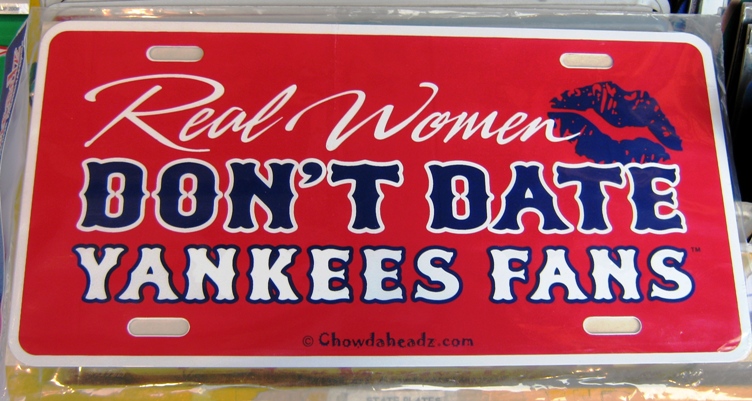
Now you know what to get for lady Sox fans.
There is a very cool selection of Red Sox earrings on Amazon…a great gift for the lady Sox fan. (or hey, a progressive guy Sox fan). Check out this pair, or this pair…they’re both great.
And what goes better with Red Sox earrings than a decorated bow? This one is surprisingly affordable…and you’re working it now, buddy.
You can find some really cool tees here (I even checked the free shipping box for you)…
But this one is amazing looking, and I say this as someone who’s not a big tie-dye or Grateful Dead fan.
Then there’s the Citgo logo tee, the reason for which is obvious to any Fenway dweller.
And of course, your tiny young new Red Sox fan needs to show his colors early.
As far as fandom and showing allegiance, do you want to be one of those really weird fans that stands out even in a Red Sox-apparel adorned crowd? Then this suit is for you…go for it! (I’m not sure I would give it as a gift though.)
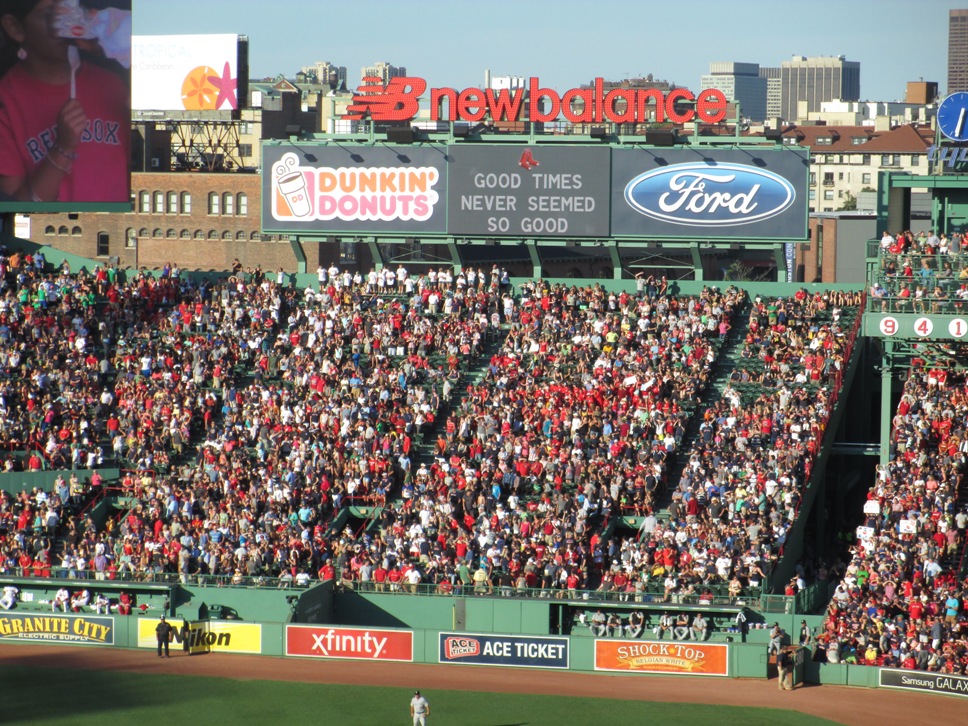
Note the virtually complete absence of shade.
Gifts For Red Sox Fans, Part 3: Necessary Fenway Accessories
If the Red Sox fan in your life is going to Fenway and is planning to sit in the bleachers, listen up…they are going to need sunglasses! Take it from this Fenway Park expert…
Here’s a very cool pair of Red Sox branded sun frames for those bright bleacher afternoons.
Other essential Fenway visitor items include cooler bags, because as you may know, you can bring your own food and non-alcoholic drinks into Fenway. (Read more about that here.)
Seriously, share this knowledge when you hand the Red Sox fan in your life their Red Sox cooler bag.
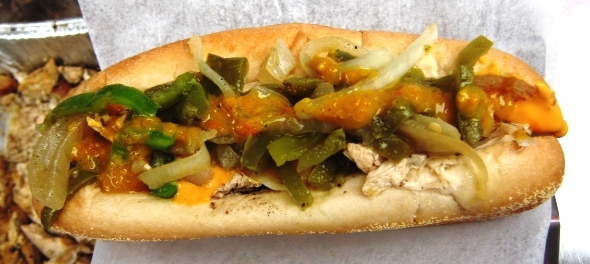
Wrap up this beauty of a chicken teriyaki sandwich and sneak it into the ballpark!
You can easily fit your sandwich from the Sausage Connection into this thing…
And this cooler bag will just as easily store your sodas and bottled waters (and it’s cheaper).
Obstructed views aren’t the only problem with Fenway’s Grandstand seats. They’re also small and hard to sit on. A Red Sox seat cushion makes a great gift for anyone who likes the Grandstand seating.
If you’re out in the bleachers, or in the Green Monster seats, you’ll want to be prepared if the rains come. Check out this ultra-cool umbrella.
If you’re paying the considerable price for a beer at Fenway, keep it cold. This.
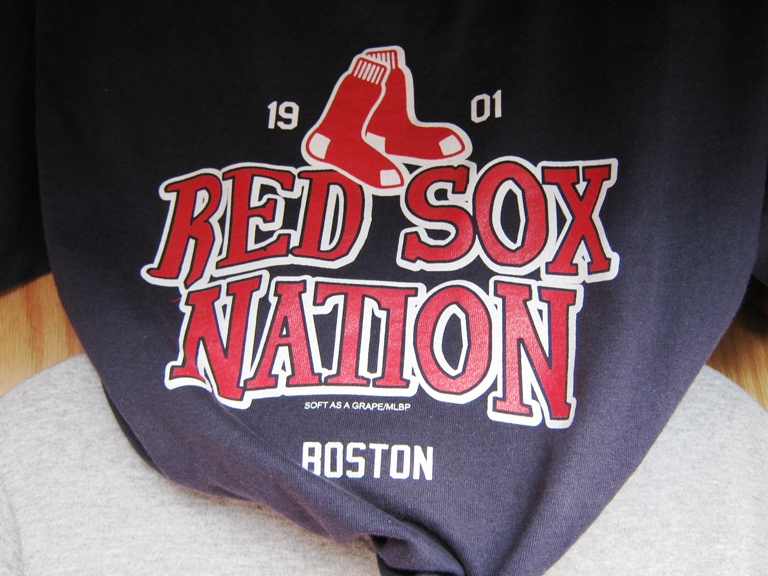
Membership includes a Red Sox fanny pack!
Gifts For Red Sox Fans, Part 4: Car Décor, Books, and the Best Yankee Hater Gift of All
If the Red Sox fan in your life is driving to the game, at least help him or her decorate the car accordingly, with championship accessories…here’s a particularly nice license plate holder, and here’s a car flag…two excellent and affordable stocking stuffers!
OK, maybe it’s not Fenway necessary gear, but while your lucky gift recipient is waiting for the baseball season, they will need some Red Sox reading material.
I confess to not having read all of these, but they are recommended in posts that I’ve read…
This is a best seller from the very popular Jerry Remy, currently a Red Sox broadcaster. I would check somehow and make sure your Red Sox fan doesn’t have it…you can’t go wrong with a Jerry Remy book for a Sox fan.
Stewart O’Nan is a terrific writer, and I don’t need to tell you who Stephen King is. They decided to chronicle an entire season of Red Sox baseball together. In 2004. Again, check and make sure your fan doesn’t already own this one…
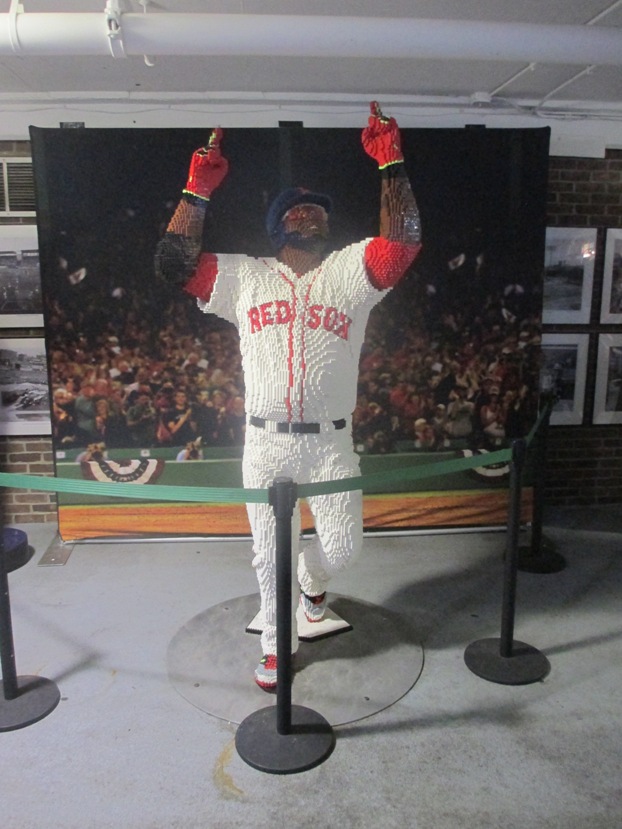
Yes, this man is this beloved in this town.
Here’s another subject that’s always a winner with Red Sox fans.
Finally, I had to include this book just for the title. It’s almost worth the price for a Red Sox fan just to have it on display in your home.
And while I don’t know if you can buy it anymore, what Red Sox fan wouldn’t want to use this?
There you go my friend…some fantastic and useful gifts for Red Sox fans, especially for their next trip to see the Sox at baseball’s most historic and storied ballpark.
Speaking of, be sure to get the Red Sox fan in your life to check out some great Fenway Park tips…have them start here!

Great Gifts For Yankees Fans and Stadium Visitors

If you’re struggling to choose gifts for Yankees fans in your life, I’m here to help.
Well, at least with the part about what fans need visiting Yankee Stadium. Tickets make a great gift obviously, and I’ve written a short primer here about finding deals on Yankees tickets.
But fans need other stuff too. Check out the very cool gift ideas for Yankees fans below…especially the truly awesome Hawaiian shirt!
Stop paying ballpark prices for your Yankees gear and souvenirs!
Order your essential Bronx Bombers items before you go at Amazon.com, pay far less than you would at the game, AND get free shipping on orders over $25…order your Yankees swag today!
So you know, I’m including Amazon links here, and Amazon is an affiliate of mine. If you make a purchase using one of these links, this website earns a commission, at no extra cost to you. (Thanks for your support!)
So here we go…
Gifts For Yankees Fans, Part 1: Staying Warm in October
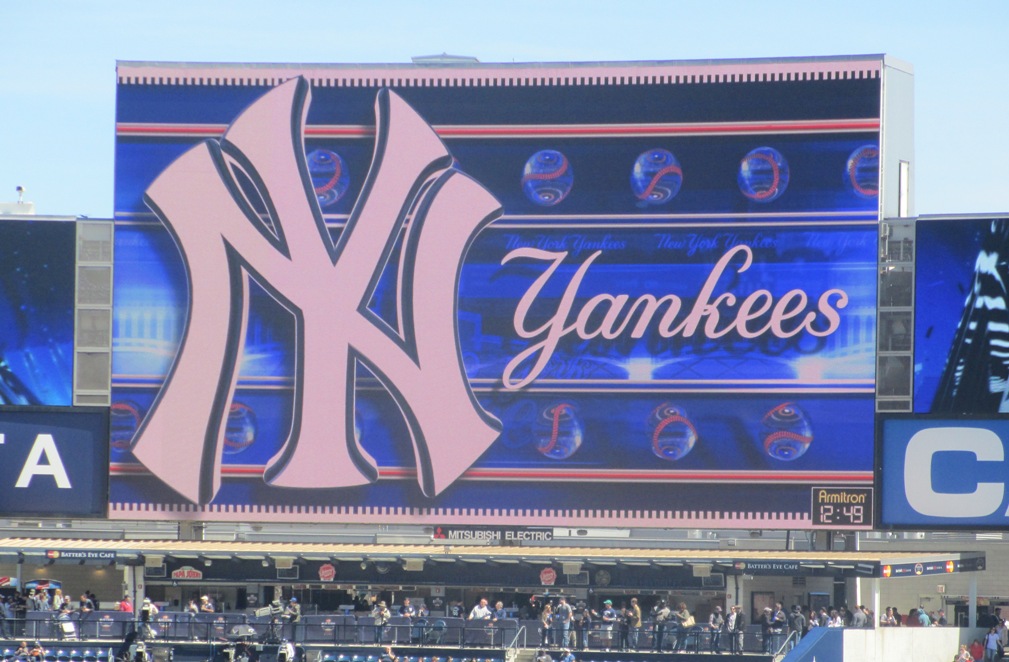
Just in case you were curious who plays here.
As every baseball fan knows, the Yankees play in October a lot, and cooler weather does hit the Big Apple. Make sure that your Yankees fan gift recipient is prepared for playoff events at the Stadium.
Hoodies make a great gift, and Amazon has a decent selection of them. This one is my favorite, but check out the rest of the selection here.
If you’re going formal, say, attending a game in a suite, you’ll stand out in this fine sweater…
Here is a pretty nice Yankees scarf, at a pretty nice price. Or try this one…(Amazon’s choice!)
I love these sneaker slippers, which have been featured on Shark Tank. (They have Cubs and Red Sox editions of these too)…
And these footie slippers would look great on a lady Yankees fan.
The Yankees fan in your life will need this knit cap if they’re headed to the Stadium for October baseball…it’s on the pricier side, but what the heck, it’s a gift. Actually this one is pretty nice too, and a little cheaper.
Stocking Stuffer Alert! Here is a pretty nice pair of gloves for a Yankee fan, because you thought of it!
Gifts For Yankees Fans, Part 2: Essential Stadium Items.
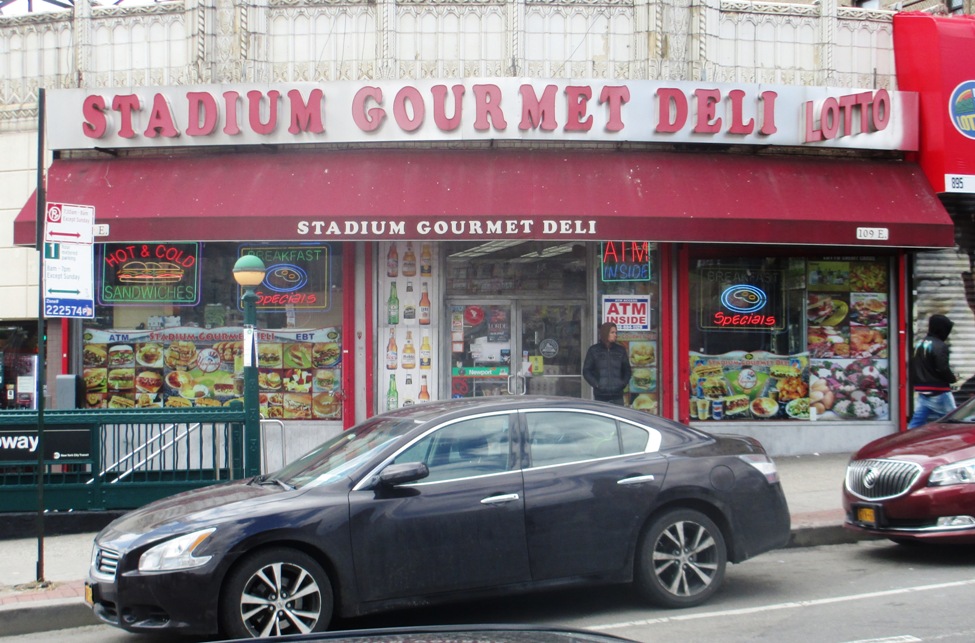
“We don’t hire marketing people to come up with a fancy deli name, and we pass the savings on to you!”
There are some tools you need when you visit Yankee Stadium…not just caps and tees and gear.
As I’ve noted here, you can bring your own food into Yankee Stadium…this is a perfect way to take advantage of that Stadium loophole and save mucho cash at the game!
If you’re going to pay ballpark prices for bottled beer, at least keep it cold with a sleeve. Try this fine set…
I’ve stated in my astoundingly helpful Yankee Stadium parking post that the Stadium isn’t very conducive to tailgating…but Yankees fans travel, right? So get this for your traveling Yankee fan’s next trip to Guaranteed Rate Field in Chicago or Tropicana Field in Tampa Bay…
If your beloved Yankees fan is a Bleacher Creature, they’ll need an umbrella for rain delays, and this one is large and colorful.
Stocking Stuffer Alert! And of course, you’ll need a pen to keep score.
Gifts For Yankees Fans, Part 3: Gear + Accessories.
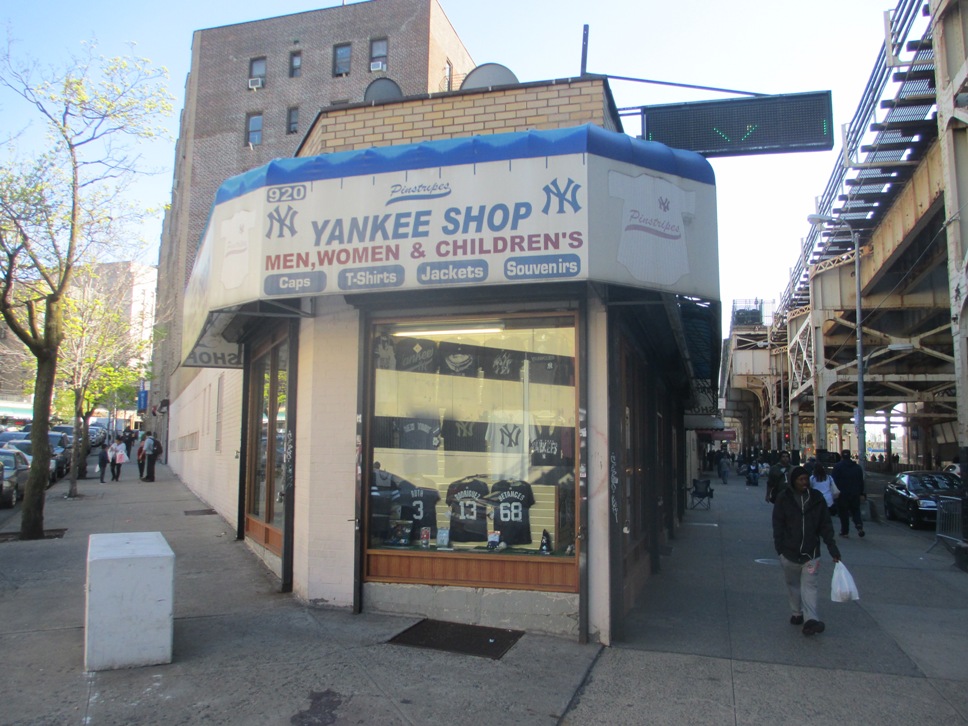
Who knows when the Yankees fan in your life will make it here?
The Yankees fan in your life needs to blend in with a sea of navy and white in the Stadium, and any extras are a bonus. Check this stuff out for gift ideas…
This outstanding Yankees Hawaiian shirt is on the pricey side, but if you’re willing to shell out a few bucks, it makes a killer gift for those warm summer afternoons at the Stadium.
If you’re looking for something for your Yankees fan dad, this tee is perfect.
Here’s a cool tee for Aaron Judge fans…
And Mariano Rivera fans will love this eye-catching tee.
Bringing a little one to the game? Would anything look more adorable on your little new Yankees fan gift recipient than these sneakers?
Here’s Amazon’s choice, an essential MLB ‘47 Yankees cap. Great price too.
But here’s a fine selection of other hats, including some nice white and pink ones. (I even checked off the free shipping box for you!)
Stocking Stuffer Alert! For the lady Yankees fan in your life, check out this selection of earrings! There’s so many great ones I can’t choose a favorite.
Gifts For Yankees Fans, Part 4: Car Items + Other Stuff.
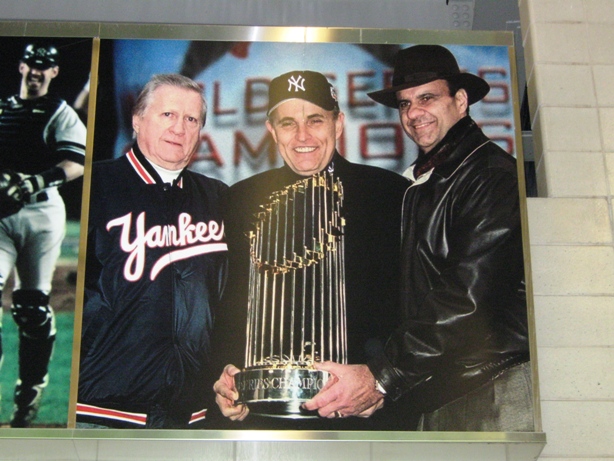
Which man pictured here was most responsible for the Yankees’ success?
It’s not all about going to the Stadium…Yankees fans love good baseball reading, and reveling in rooting for the most successful team in sports.
Does your favorite Yankees fan drive to the Stadium? You can order a seat cover, a license plate frame, a car flag, and even seat belt shoulder pads!
Here’s the classic reason why people hate the Yankees.
Stocking Stuffer Alert! Yankees fans, of course, love to talk rings…and this ring makes a great accessory, especially at this unbelievable price.
For some off-season Yankees reading, here’s a great tome from my late friend Harvey Frommer. Perfect coffee table size.
Some trivia knowledge never hurts to start a conversation in the Stadium…
Even though this book is very dated, I’m adding it because I loved it myself so much…Sparky Lyle is a very funny guy and this fantasy novel is one of my all-time favorite baseball books.
Finally, you can’t bring this to a ballgame, but it makes an outstanding mancave addition.
There you go fans, some great gift ideas for the Yankees fans in your life. Be sure to send them to this blog for more great Yankee Stadium advice!

3 Ways To Score Cheap Indians Tickets
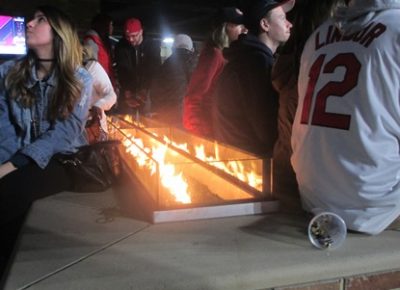
(Note: this article contains affiliate links. If you use an affiliate link to make a purchase, Ballpark E-Guides earns a commission, at no extra cost to you. Thanks for your support!)
With the Tribe at or near the top of the AL Central often these days, cheap Indians tickets can be harder to come by. But you still have some ways to save a few bucks on tickets – here are three courtesy of Ballpark E-Guides. If you want to choose from the cheaper seats, check this out.
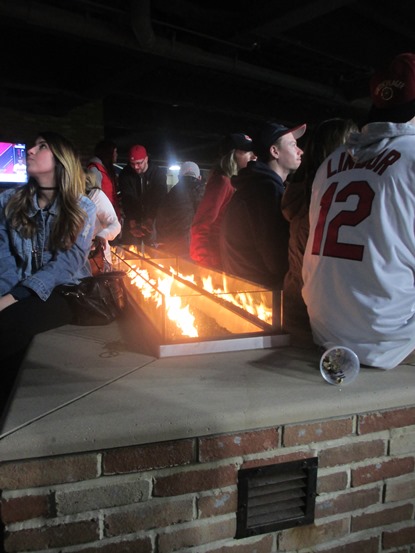
The fire pit is a chick magnet. Especially in April.
You can also order a cheap ticket and move to the upstairs section of the Corner bar, and move to the fire pit between innings. And who knows, it might not be that cold that night. I’ve gone to April games in Cleveland that weren’t too bad.
Book your ideal Indians game parking spot ahead of time…with my friends at ParkWhiz!
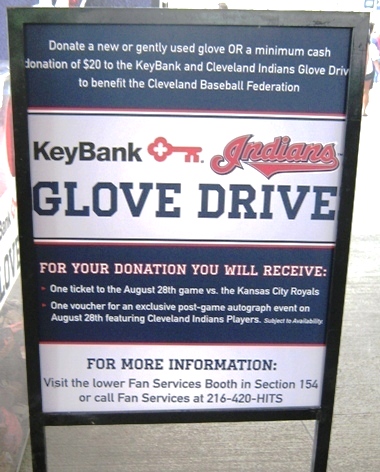
Nothing like a broken-in baseball glove.
If you give your time through the team’s Volunteer Challenge, you can reap some rewards when you build up a number of volunteer hours, including game tickets. Who says good deeds aren’t appreciated? Not the Indians!
You can find opportunities like this in the Community section of the Indians’ website.
Don’t pay ballpark prices for Tribe gear and souvenirs!
Order your essential Indians items before you go at Amazon.com, pay far less than you would at the ballpark, AND get free shipping on orders over $25…click here!
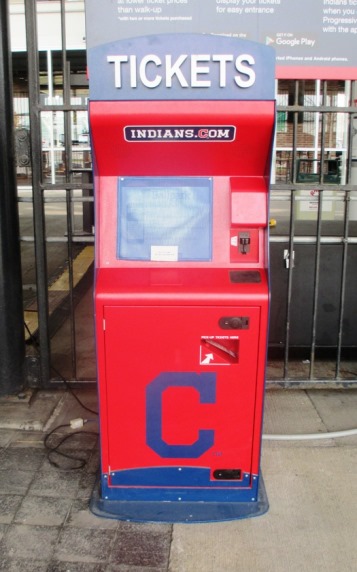
Just in case there is no one at the window.
The only exception is the District Ticket, which is only available online. Bonus tip: the Indians sometimes waive ticket fees and will tell you so in their e-mail ticket alerts; that’s the time to snag those District Tickets.
Cheap Indians Tickets, Tip #4) Bonus Tip: Try SeatGeek. SeatGeek is my favorite third party outlet for Indians tickets, and I’m not just saying that because they’re an affiliate. SeatGeek searches from a number of ticket outlets, and I frequently find better deals there than on StubHub.
There you go; three ways (+1!) for you to land some possibly cheaper tickets to see the 2016 AL Champion Cleveland Indians. Stay tuned, I’ll post more.
Want to know more about Progressive Field? Sign up here for my completely free Progressive Field e-mail newsletter series, and score some seriously valuable info about tickets, seating, transportation and food…see you at the Yard!

Miller Park Tailgating: 5 Useful Tips
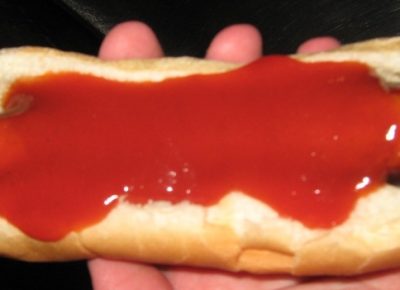
I had to move this post, sorry! You can check it out on my exclusively ballpark themed blog here!!










